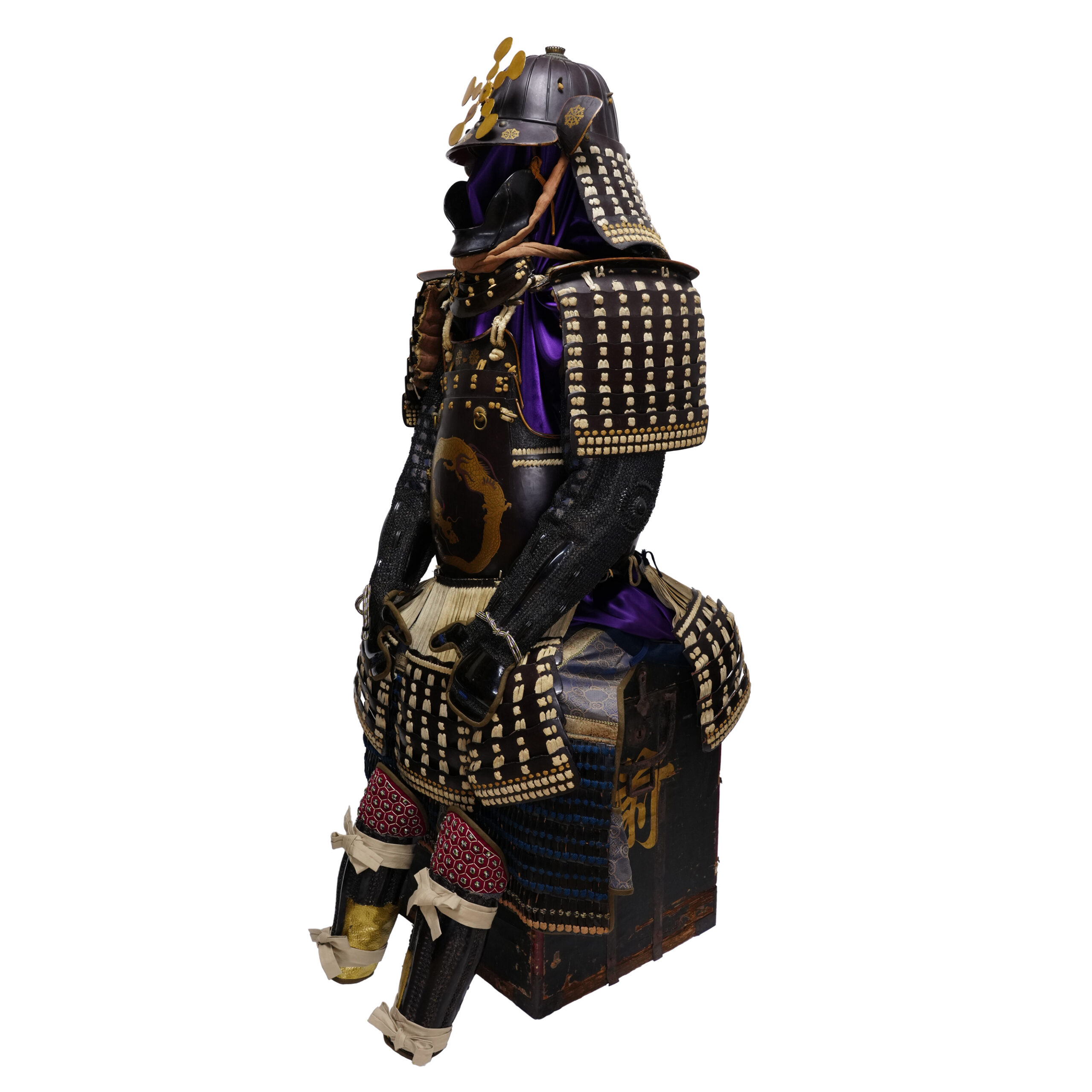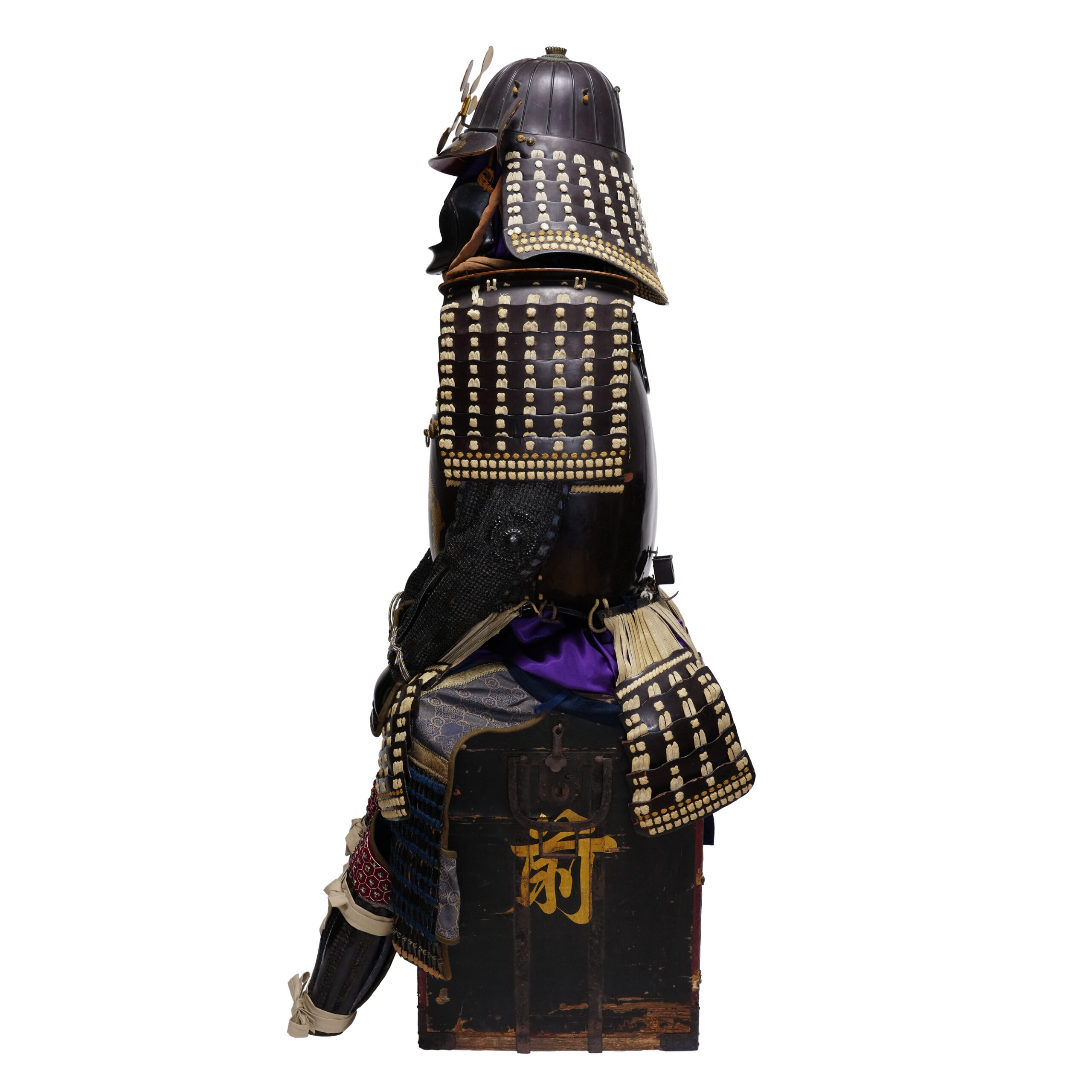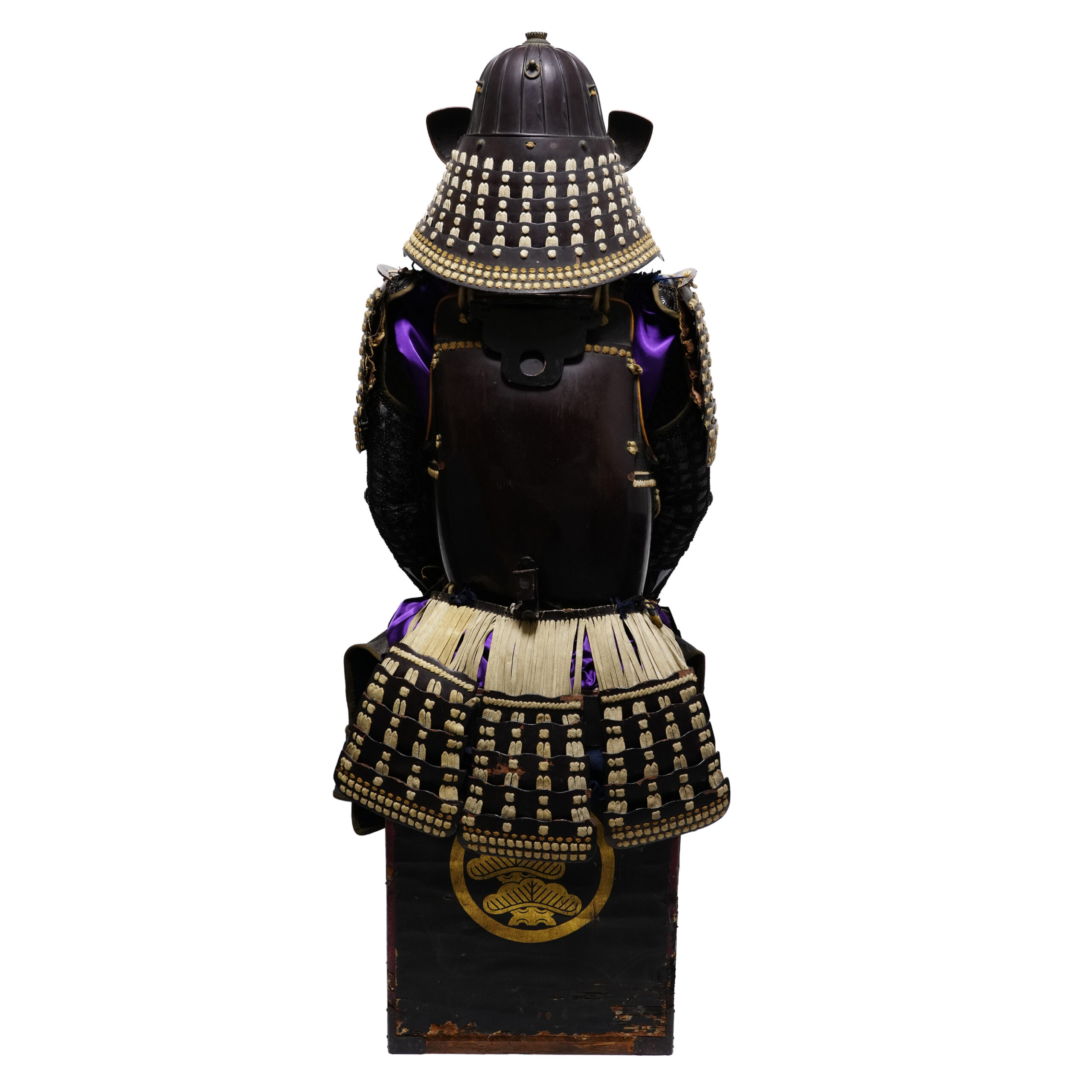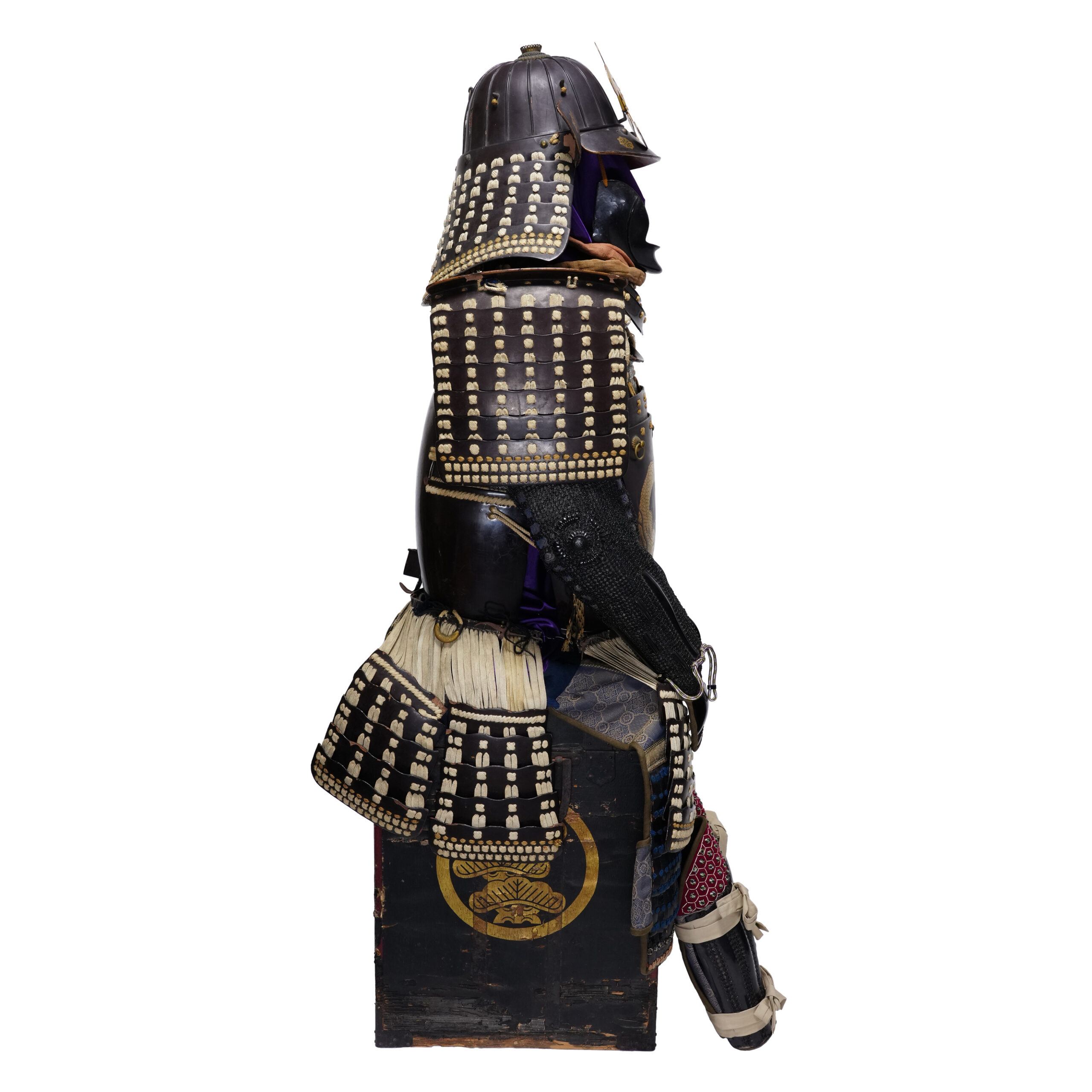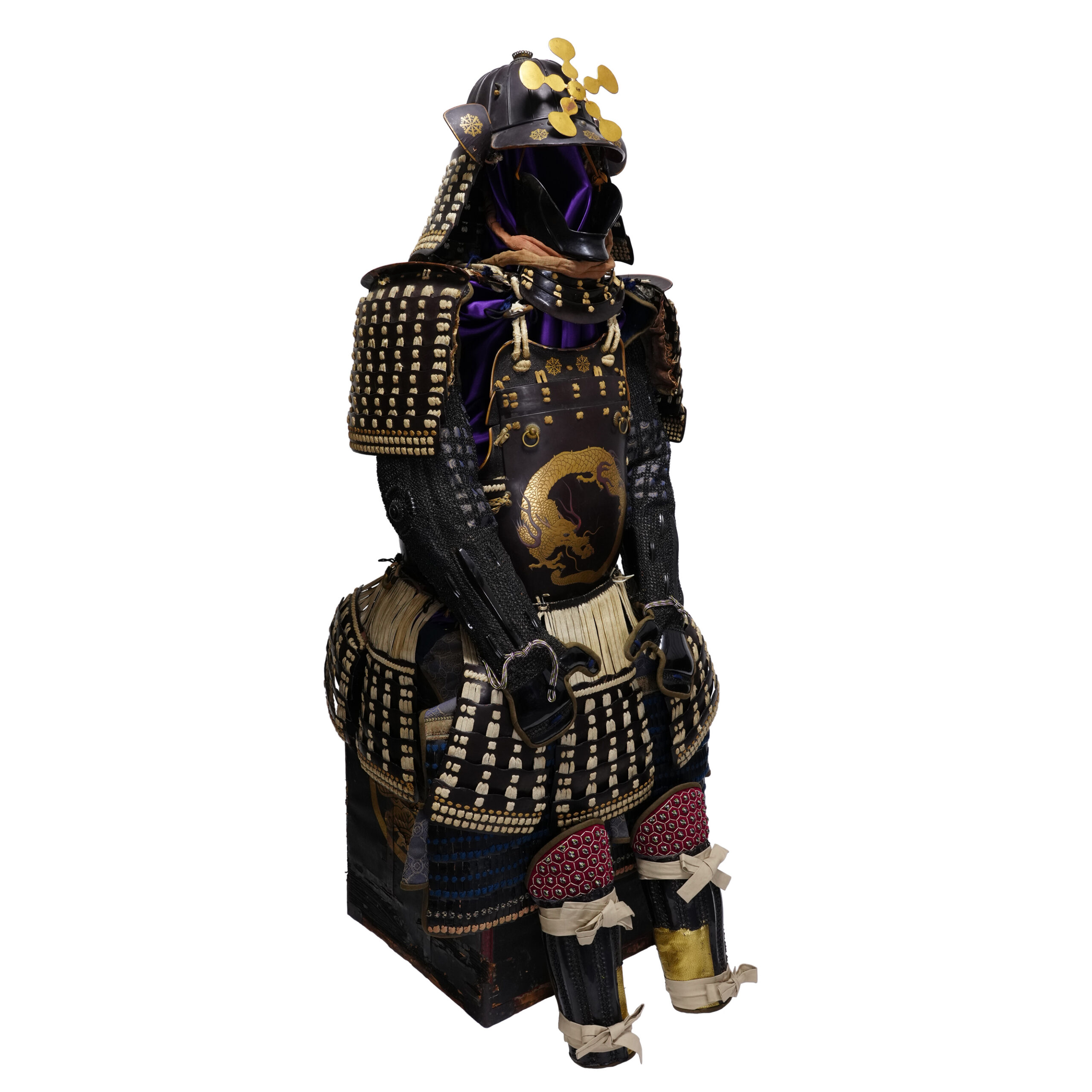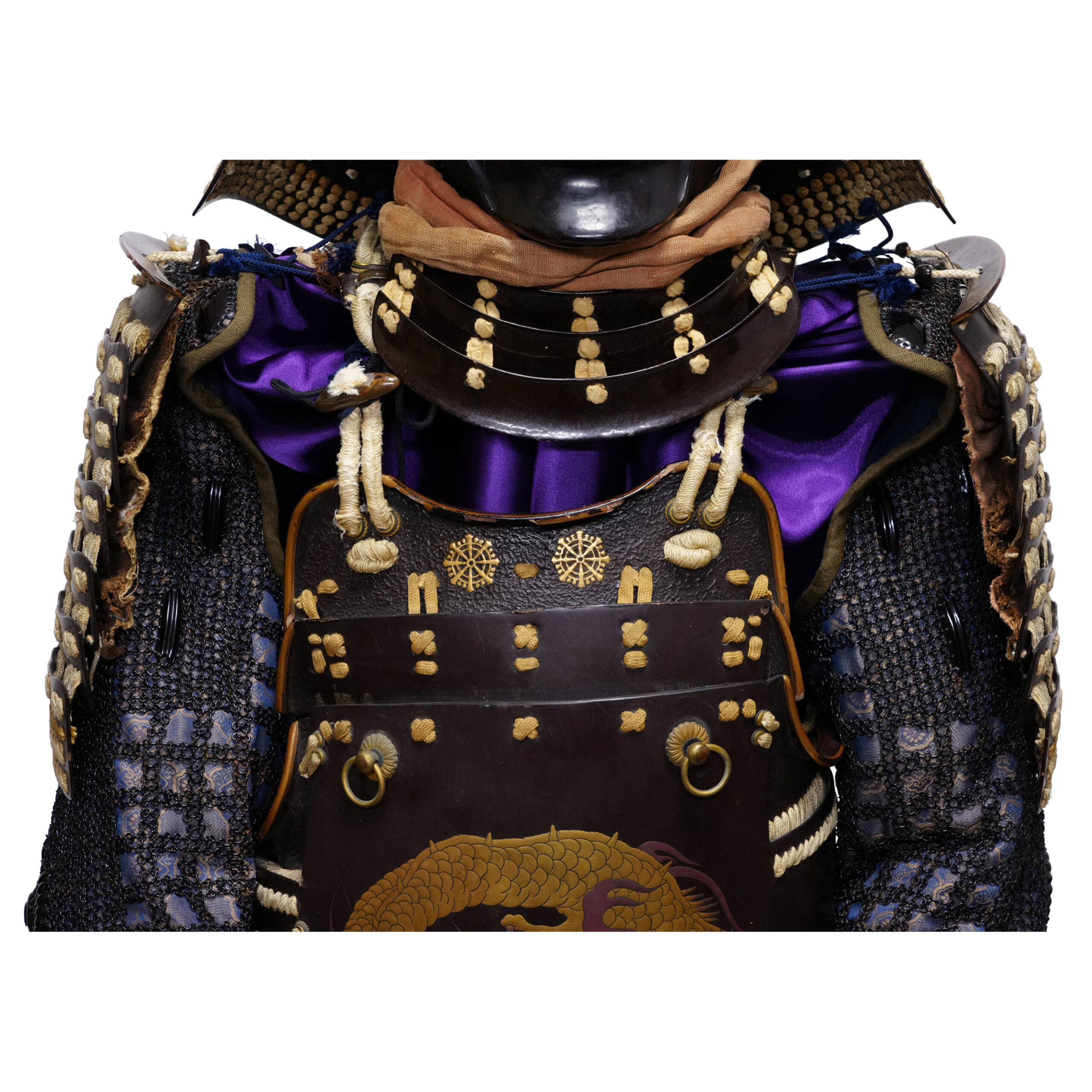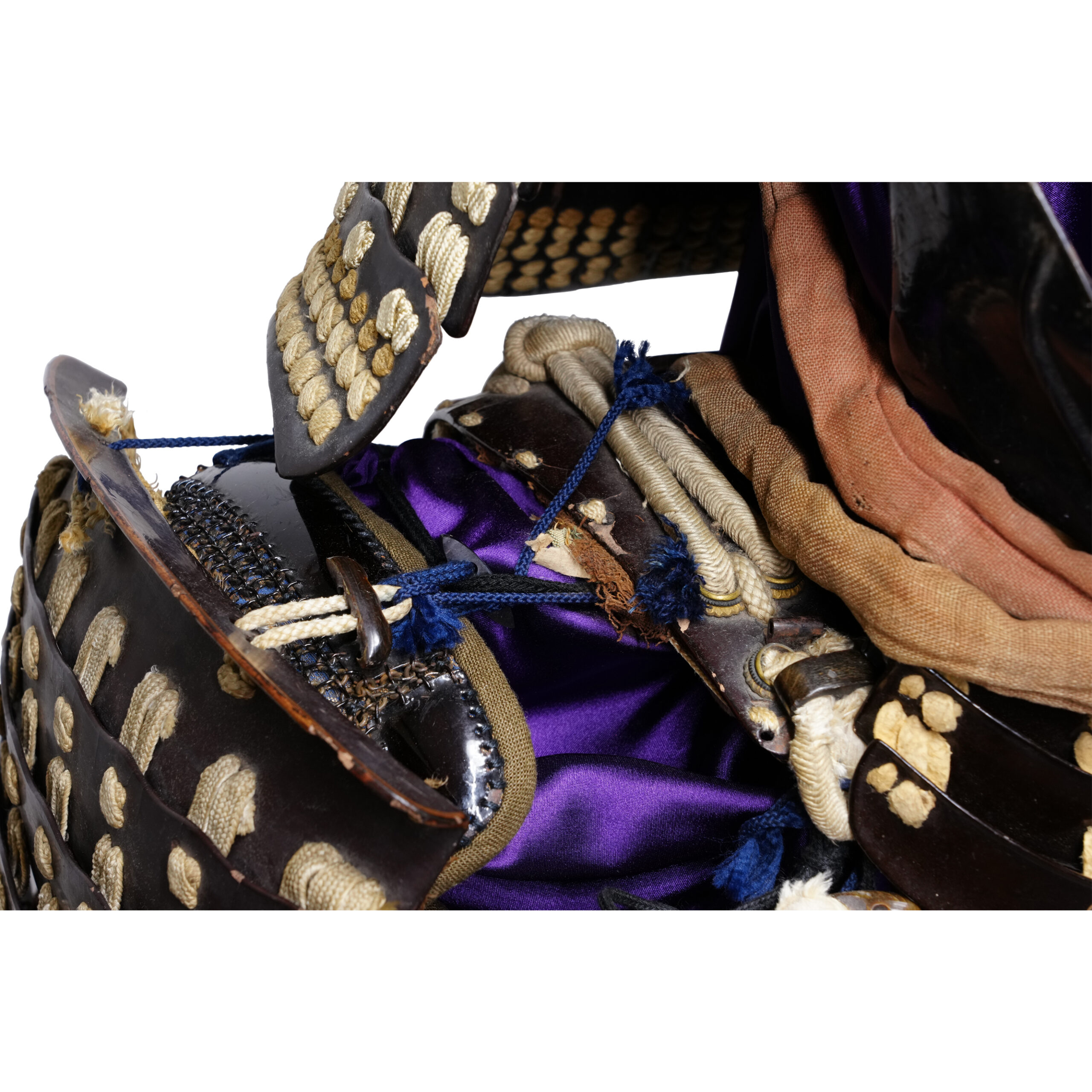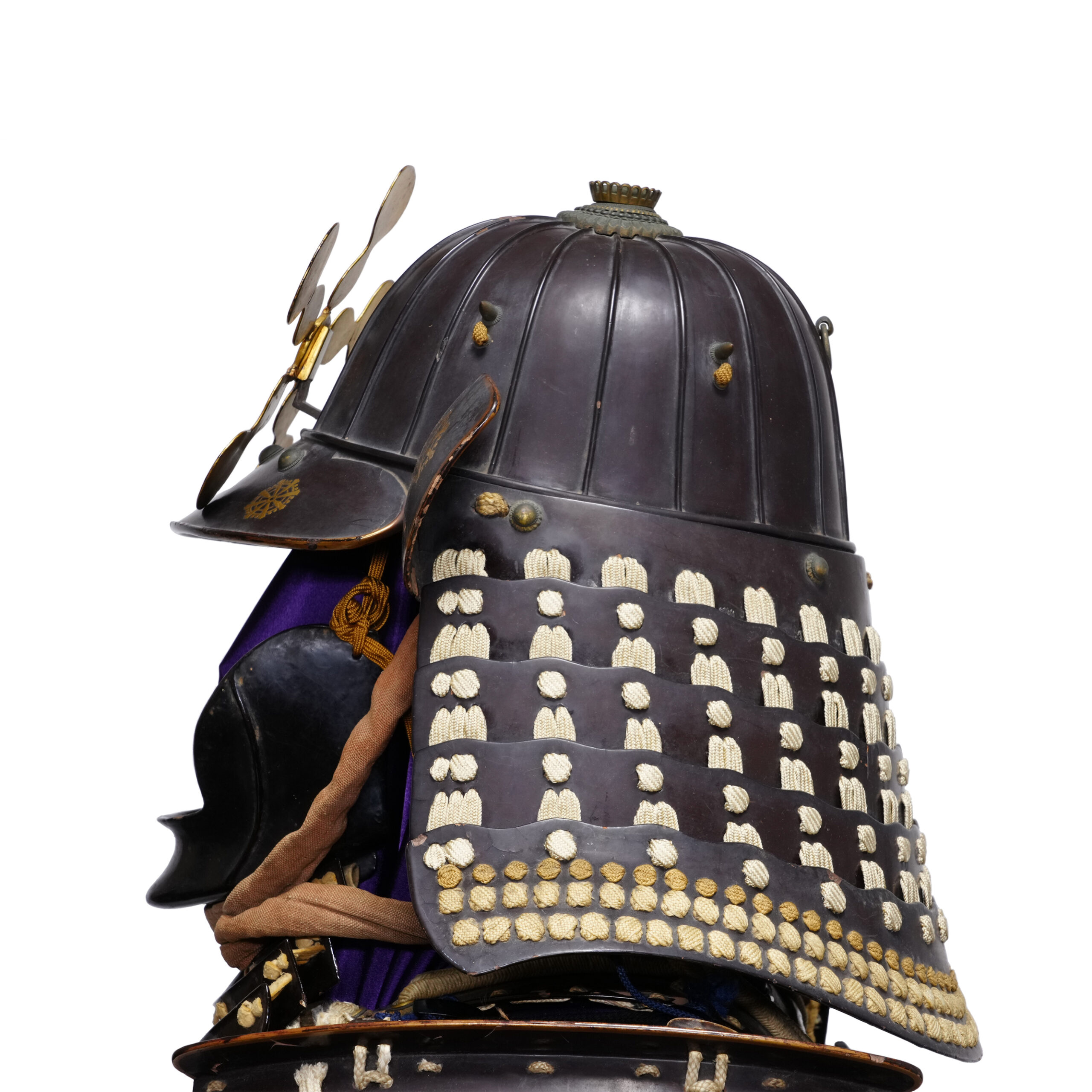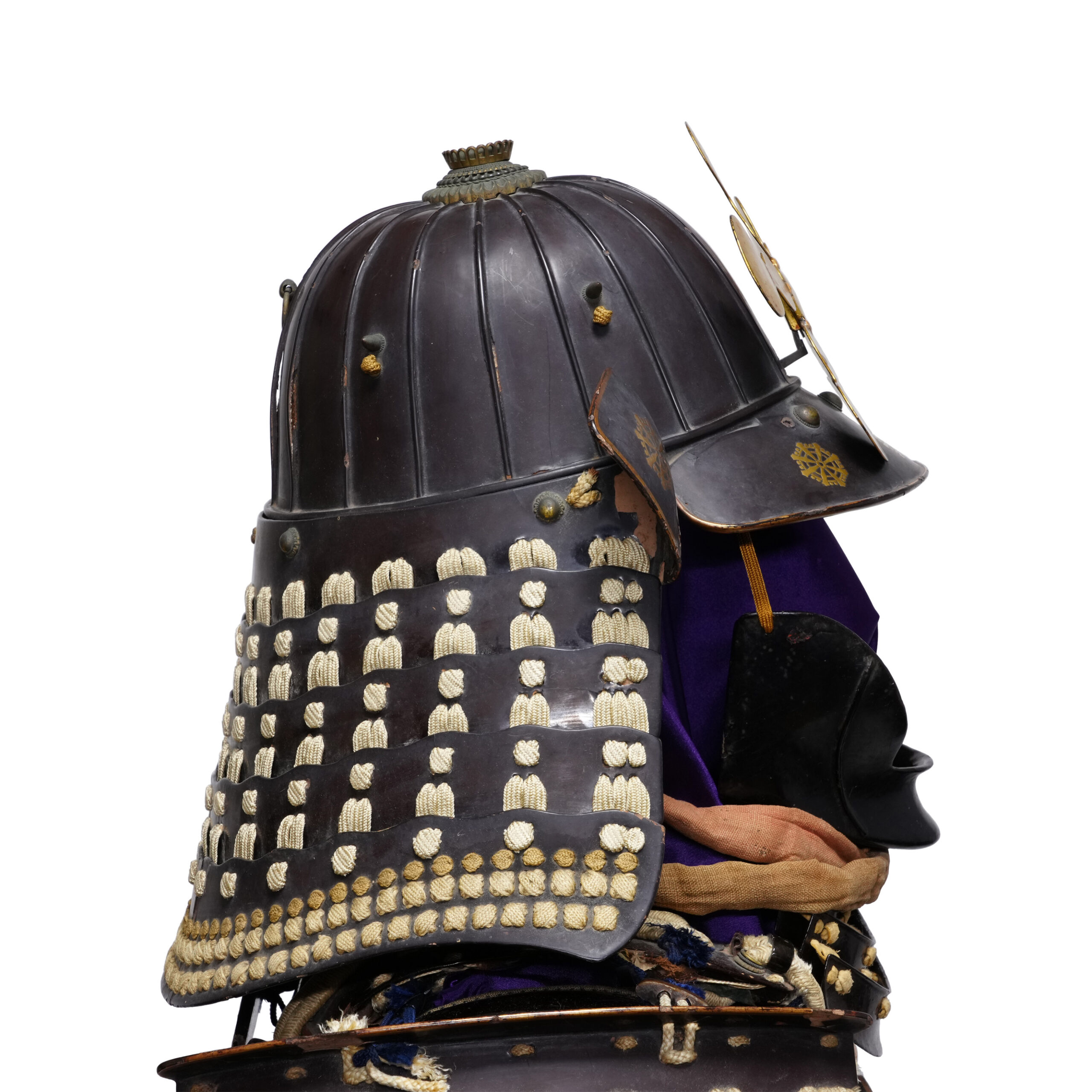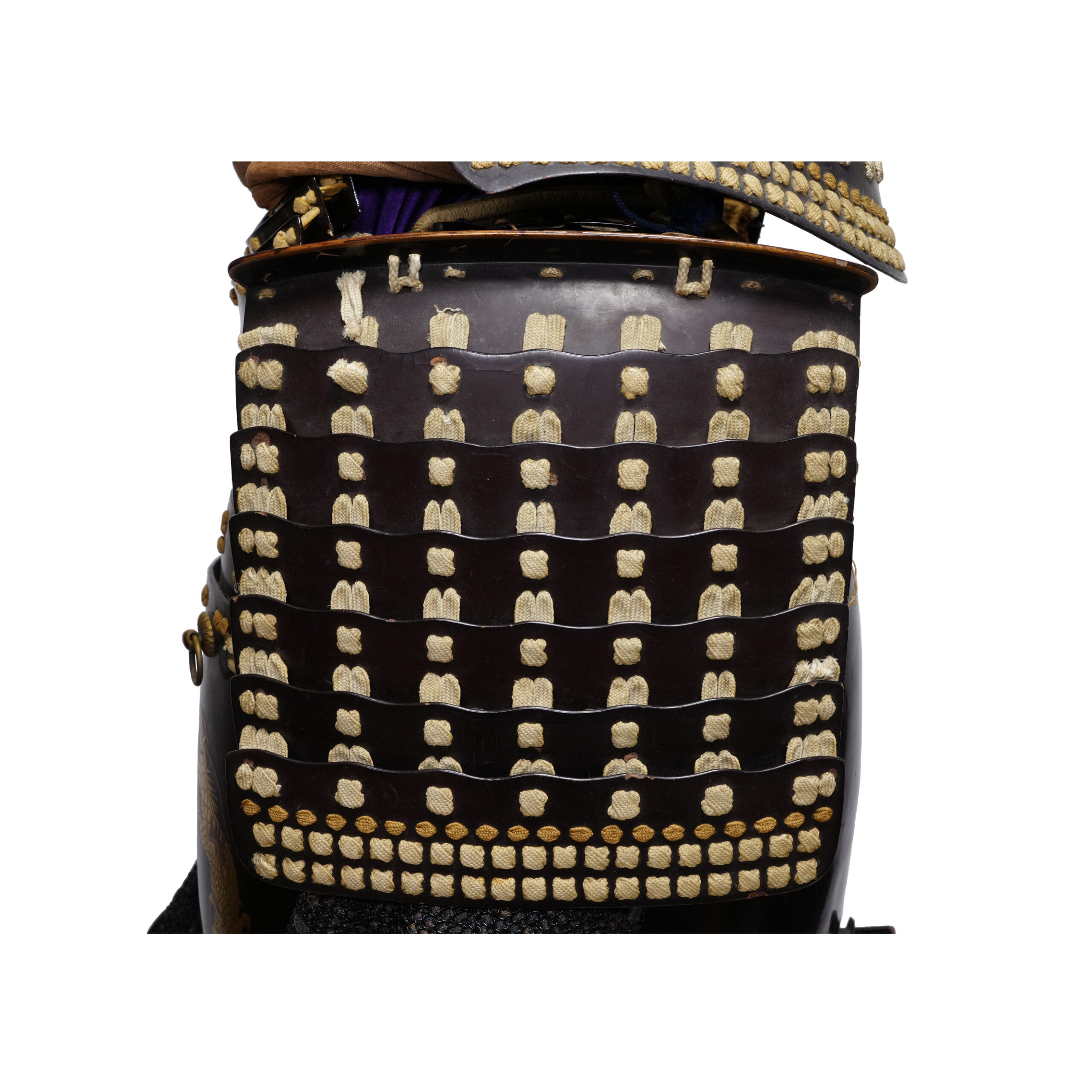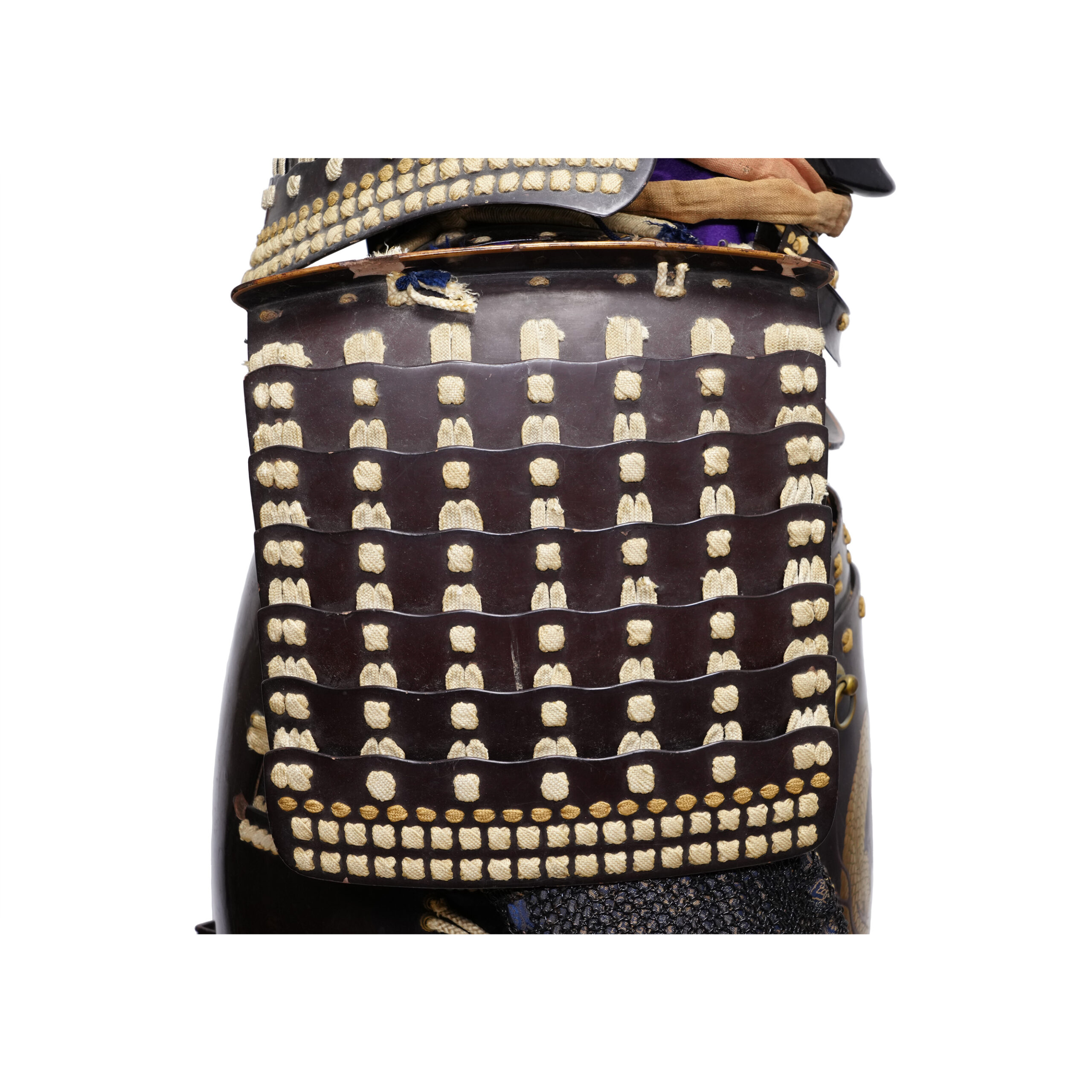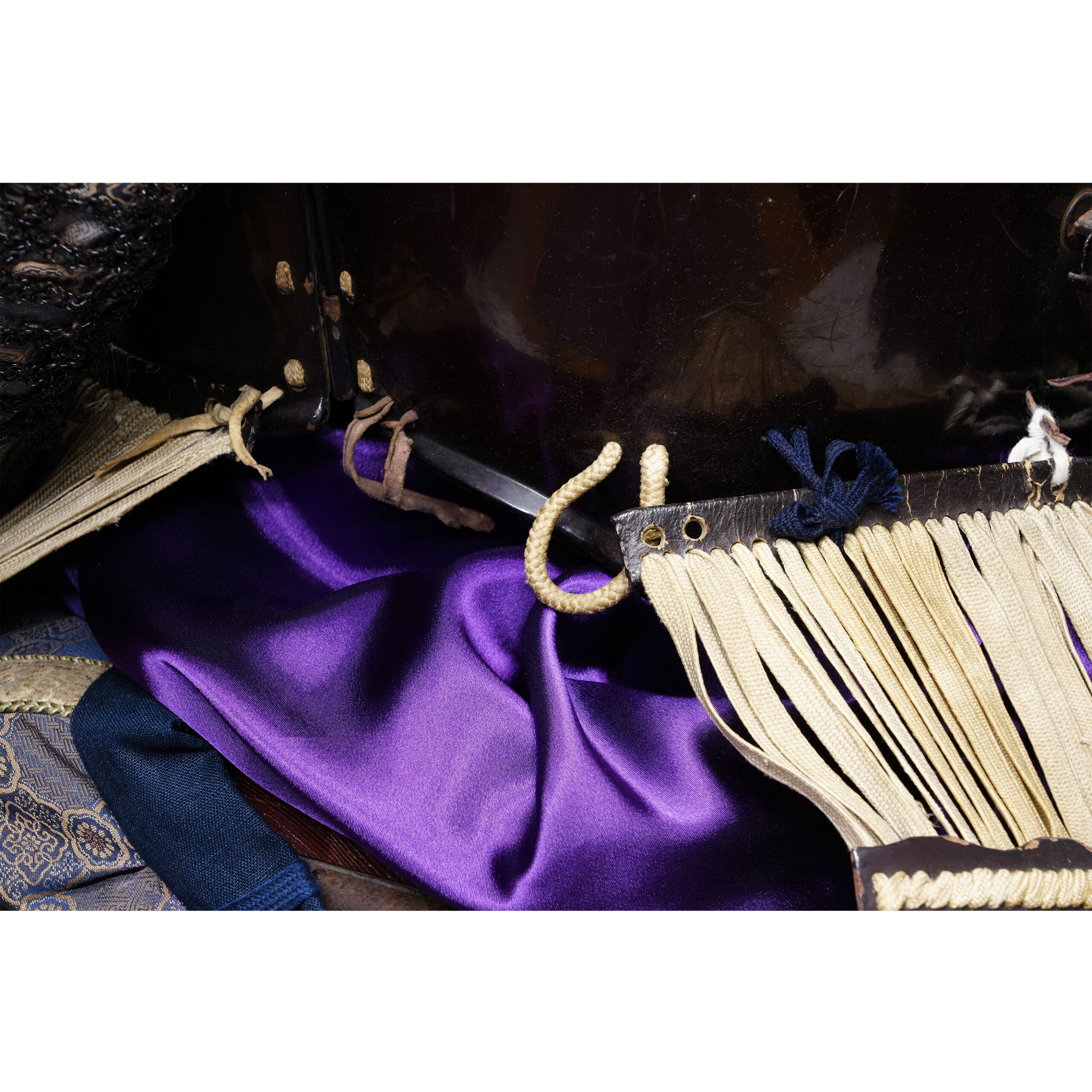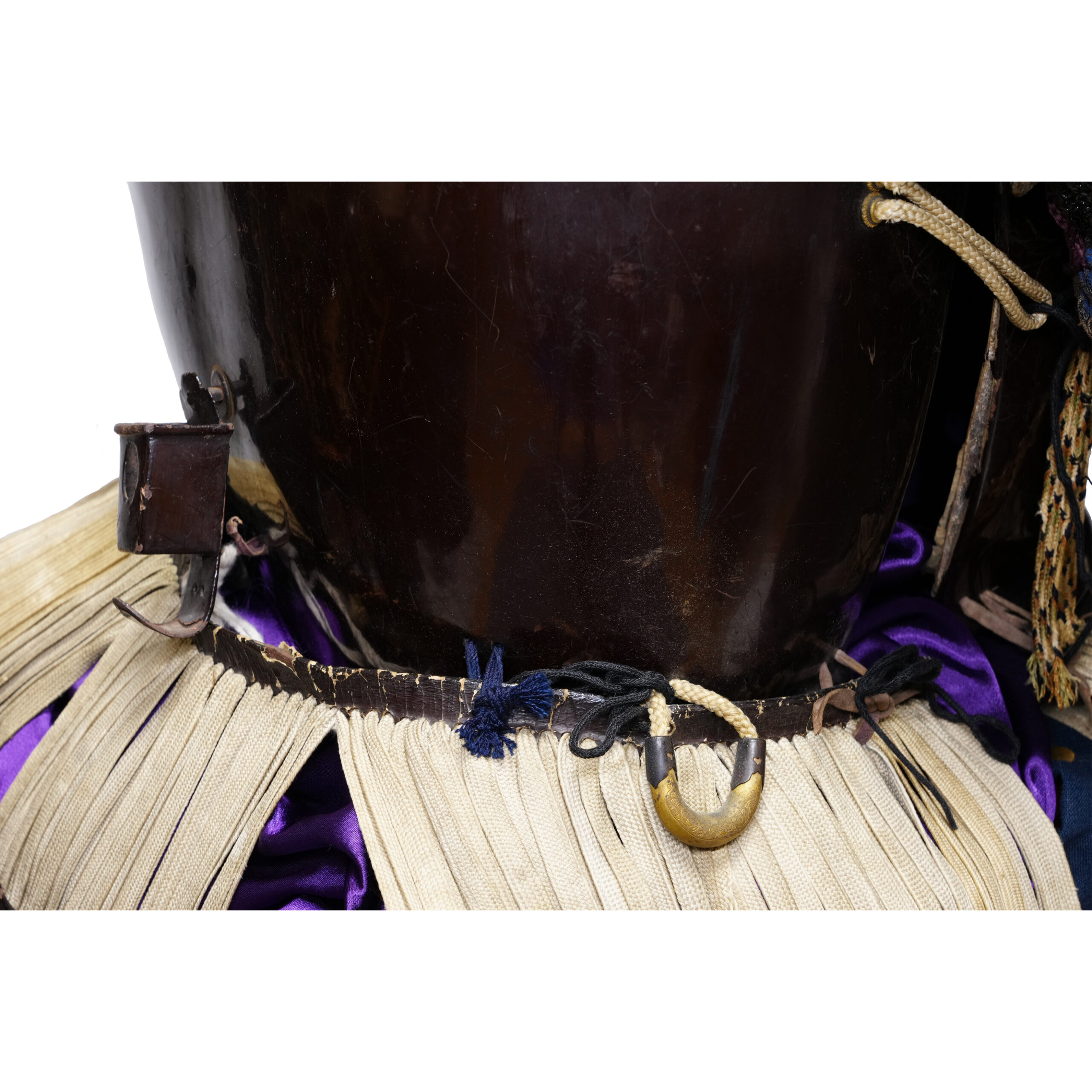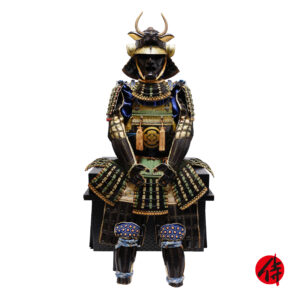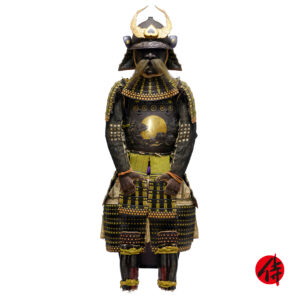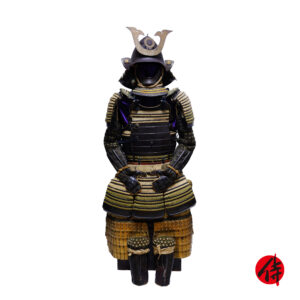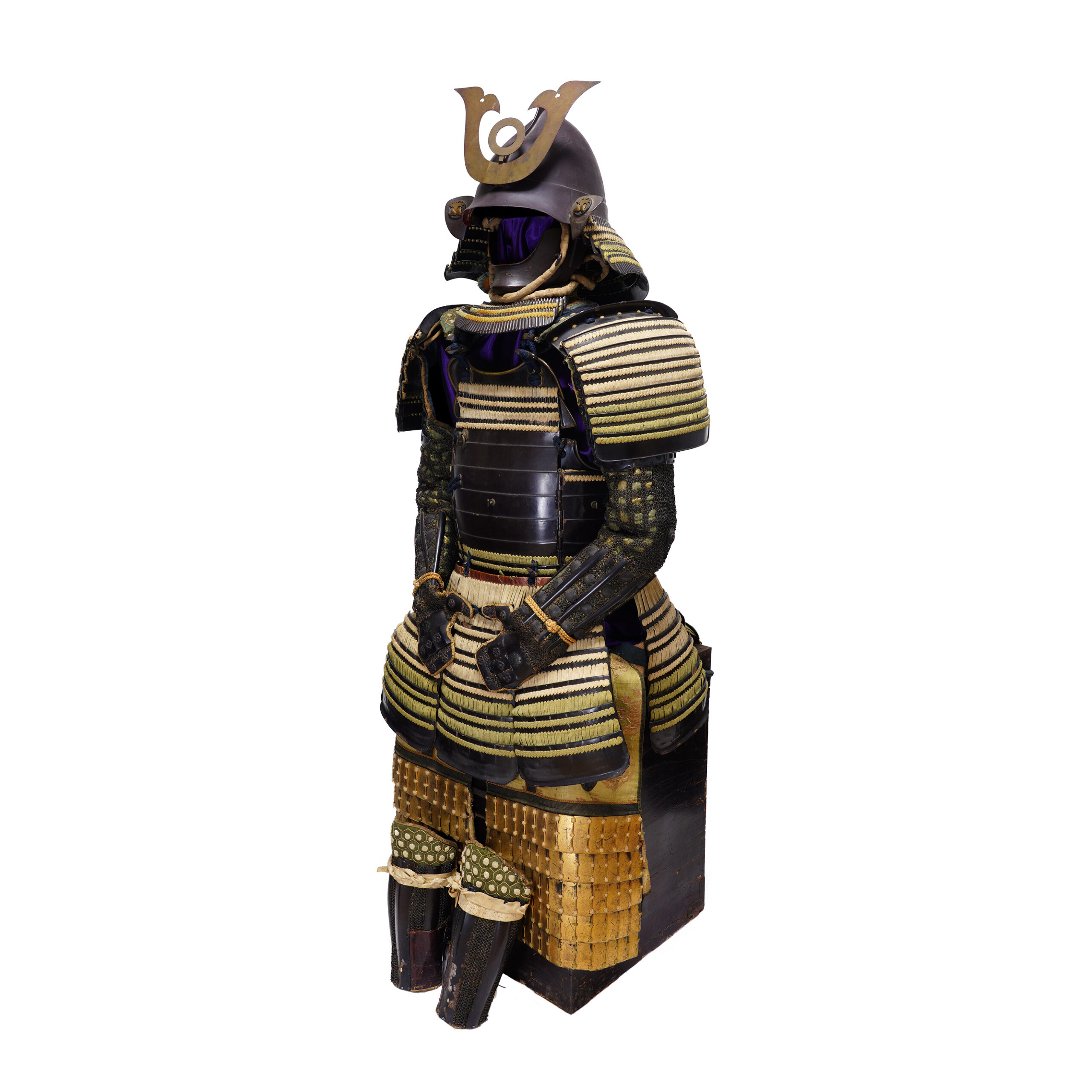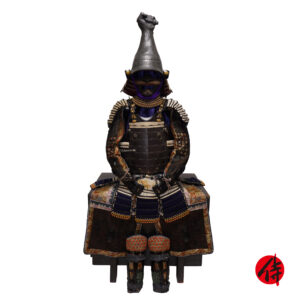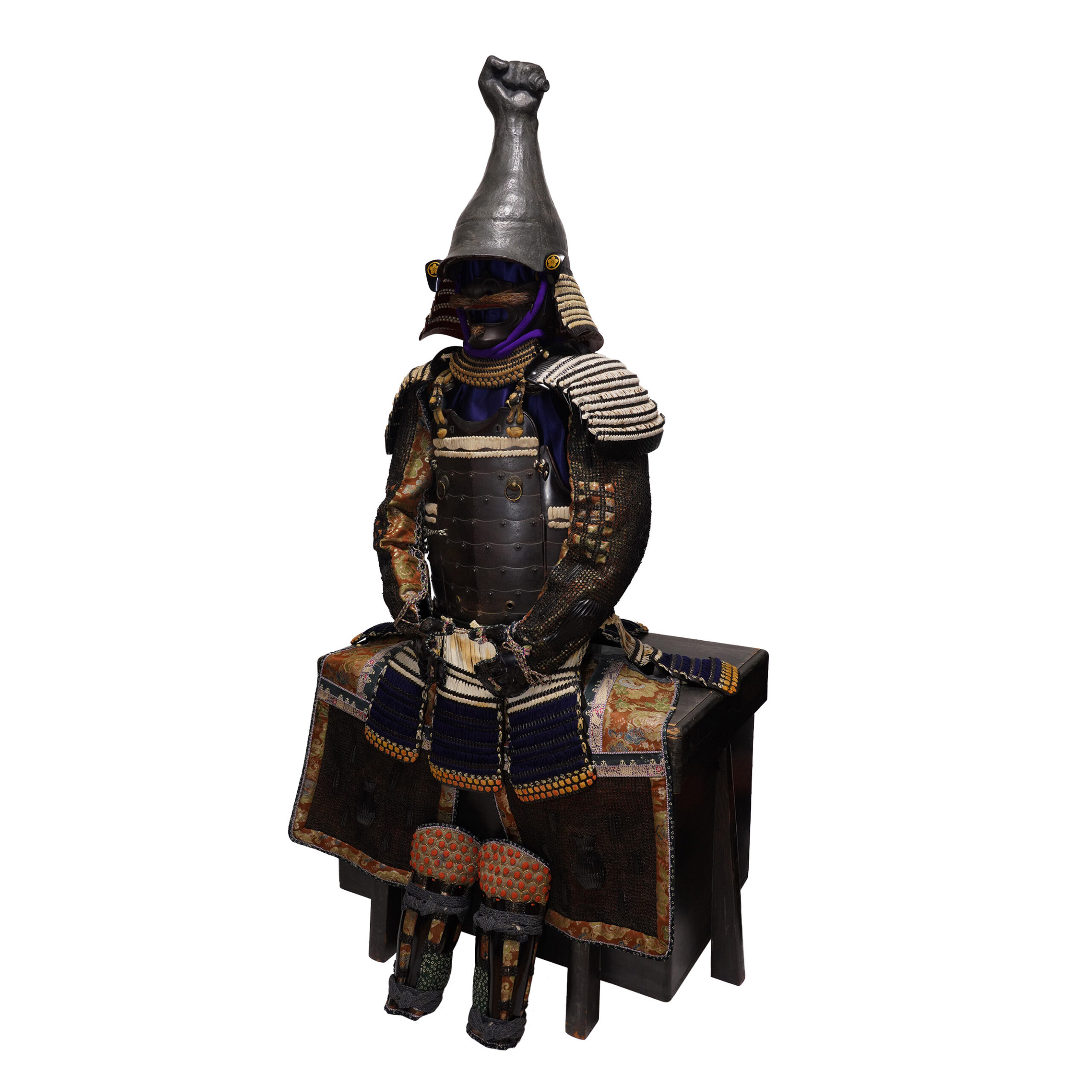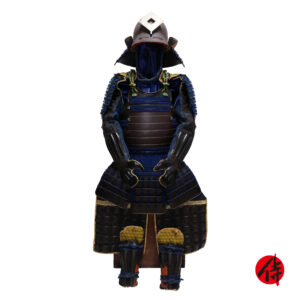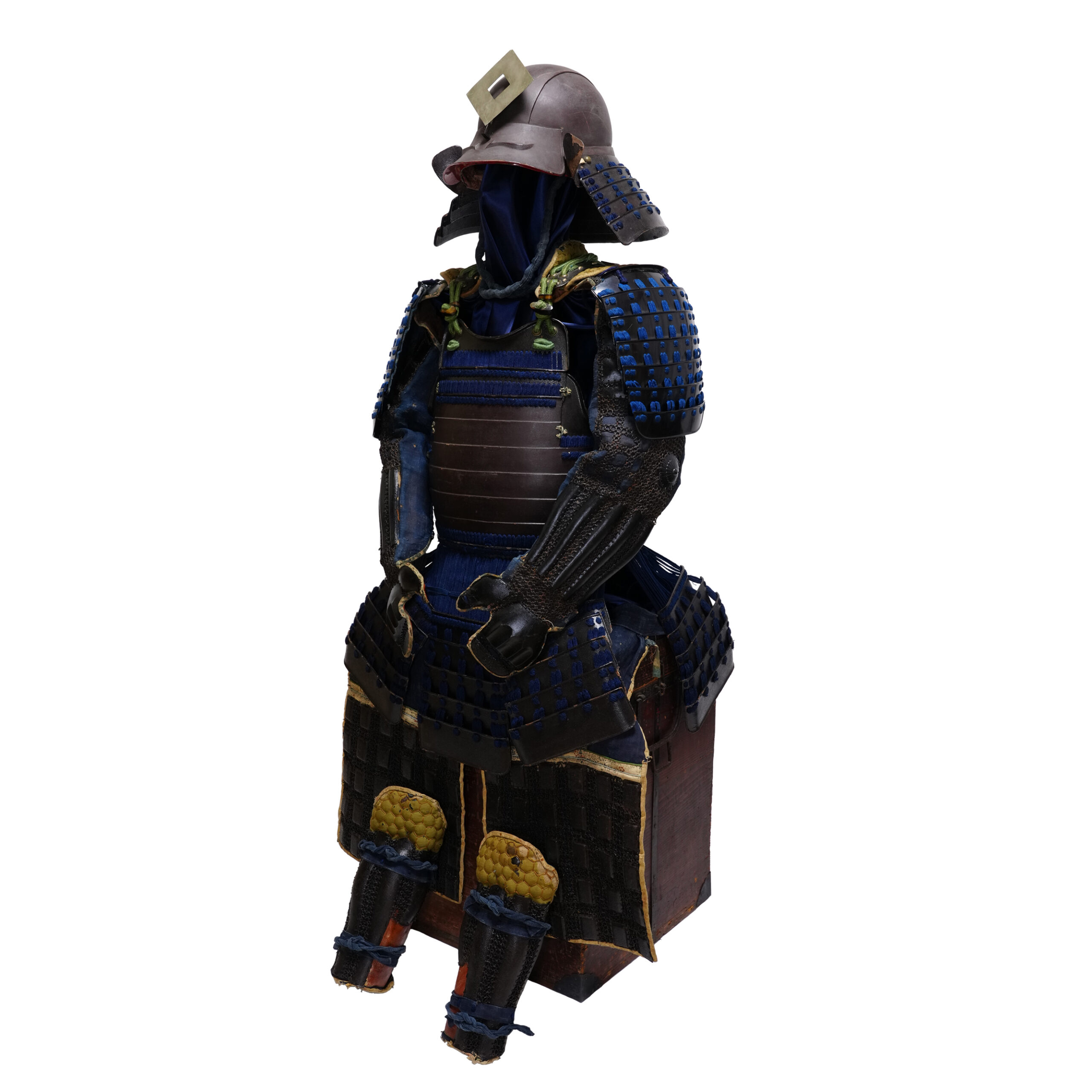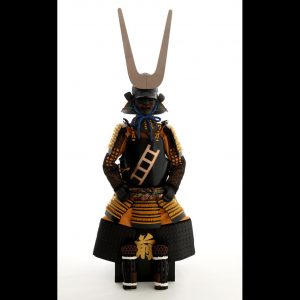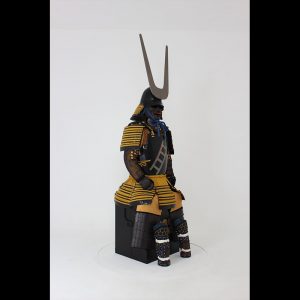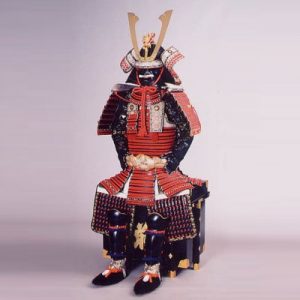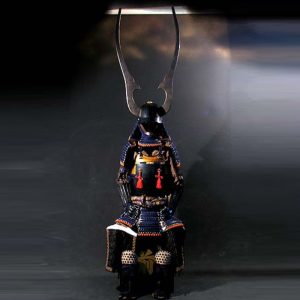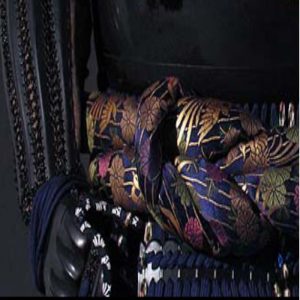Antique late Edo Period Samurai Armor Tokubetsu Kicho Shiryo Certificate (A-29)
Period: Late Edo Period
appraised by The Association for the Research and Preservation of Japanese Helmets and Armor
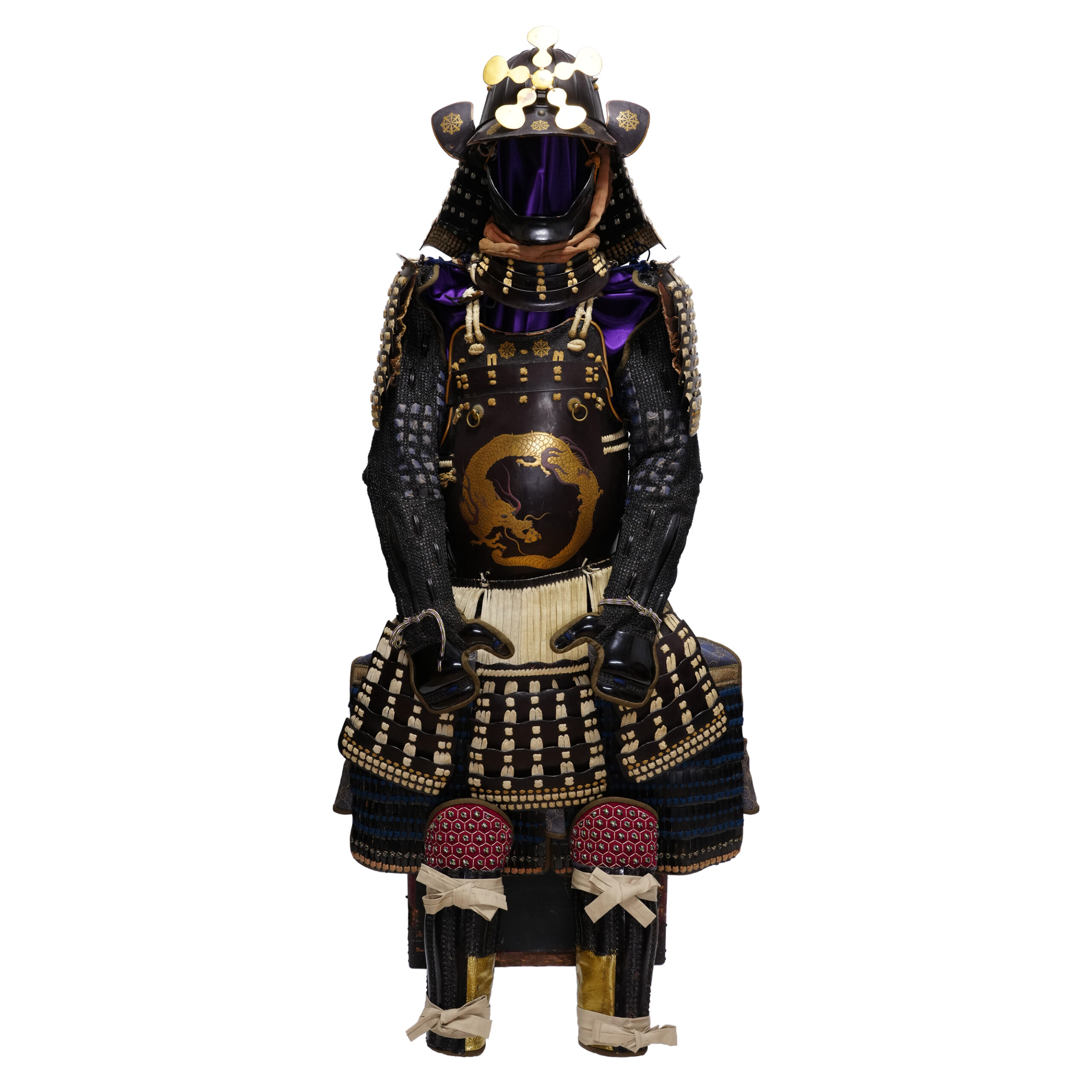
Kabuto (helmet)
■Helmet bowl: Suji Kabuto
The Kabuto (兜, helmet) is a protector for the head. When people started using the Kabuto, it was initially designed for practical use. However, the principal purpose of its design has changed with time; Samurai warriors tried to express their dignity, personality, or religion by wearing the characteristic designed Kabutos. According to a theory, these uniquely designed Kabutos were made from the late Muromachi (室町後期, 1467-1573) to the Edo period (江戸, 1603-1868). This type of Kabuto is categorized as the Kawari Kabuto (変わり兜), and a variety of materials were used to create them. For example, animal fur, seashells, plants, and paper were used as materials for decoration.
Here we would like to introduce to you a little bit more about the history of Kabutos. Before the Kawari Kabuto’s production, the Suji Kabuto (筋兜) appeared during the Nanbokuchou (南北朝, 1337-1392) period. At that time, the tactic was gradually changed from the piggyback fight style to battle with the Tachi (太刀) sword and the Naginata (薙刀, Japanese halberd) on the ground. Therefore, there was a rise in demand for the weight-saving of the Kabuto. Also, in order to turn the attack by swords, a new type of structure was invented: the Suji Kabuto (筋兜). Its form slides swords’ attacks when weapons hit the Kabuto. It is said that the production of the Suji Kabuto prospered in the Muromachi (室町, 1336-1573) period. We estimate this Kabuto is one of these Suji Kabutos made in that tendency in the Edo period. It has 18 stripes in this Kabuto, meaning 18 small iron plates are connected. It is called Ju Hachi Ken Suji Kabuto (十八間筋兜). Ju Hachi means 18 in Japanese. The surface is painted with black lacquer.
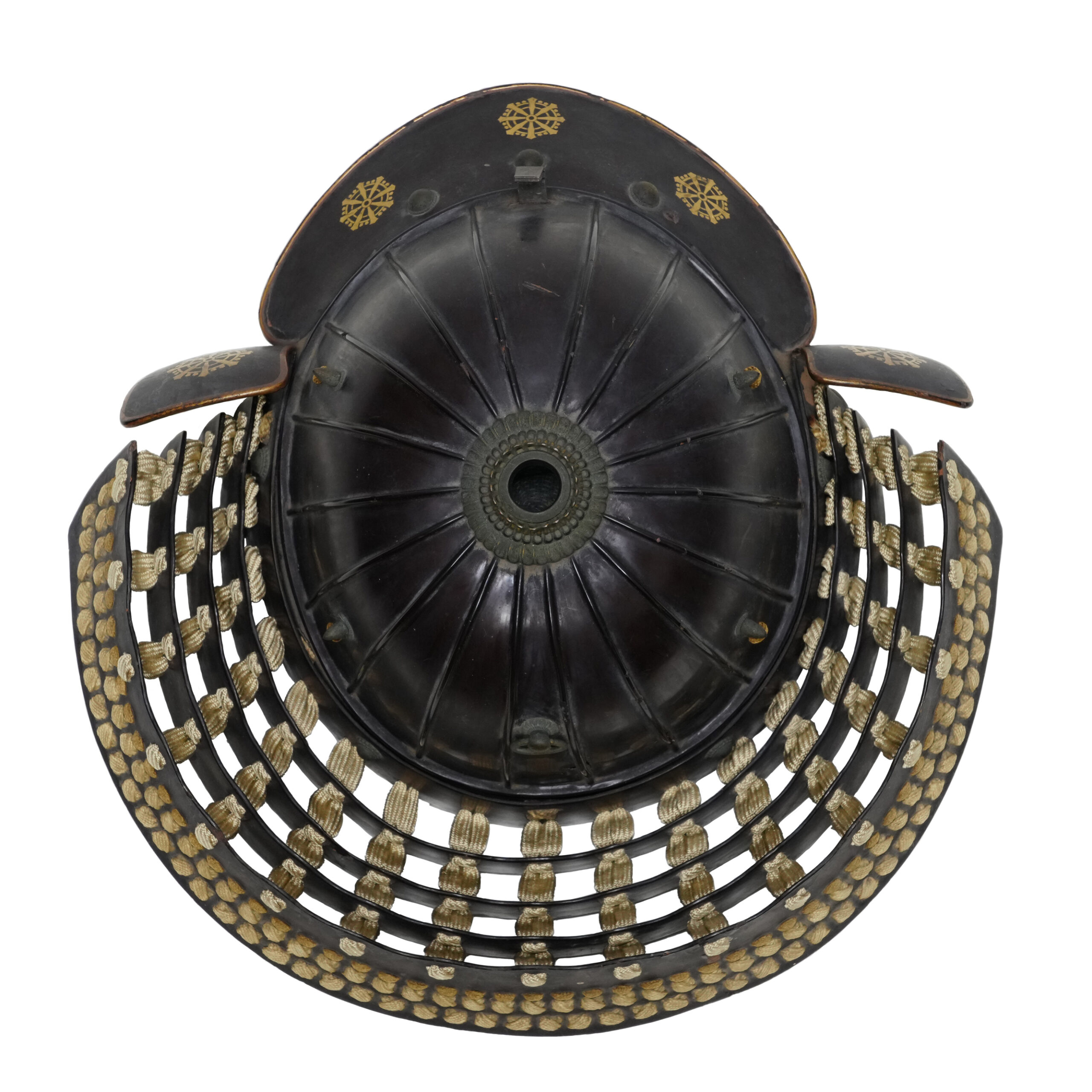

■Shikoro (side neck guard):
Iron plates laced with white threads.
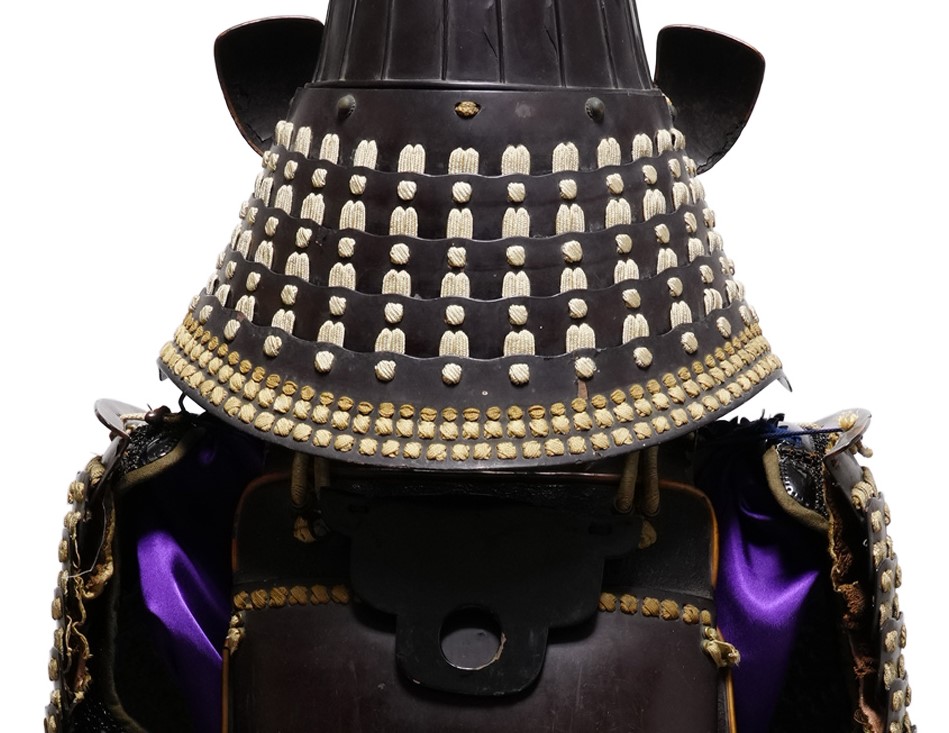
■Fukikaeshi (side neck guard): Kuruma Mon
The Fukikaeshi (吹き返し) is both ends of a Kabuto. It protects the face from swords and also shows its beautiful workmanship. Family crests are sometimes designed on this part, as seen on this Kabuto. The family crest of this Kabuto is colored with golden paint. And the same crests are depicted on its Mabisashi (眉庇/目庇, eaves of the bowl on the front of the helmet) also. We believe this family crest’s motif is a kind of Kuruma Mon (車紋). In modern times, there are cars as a means of transportation, but in the past, oxcarts using cows were common. Heian aristocrats primarily used it, and the wheel part of an oxcart came to be used as a family crest.
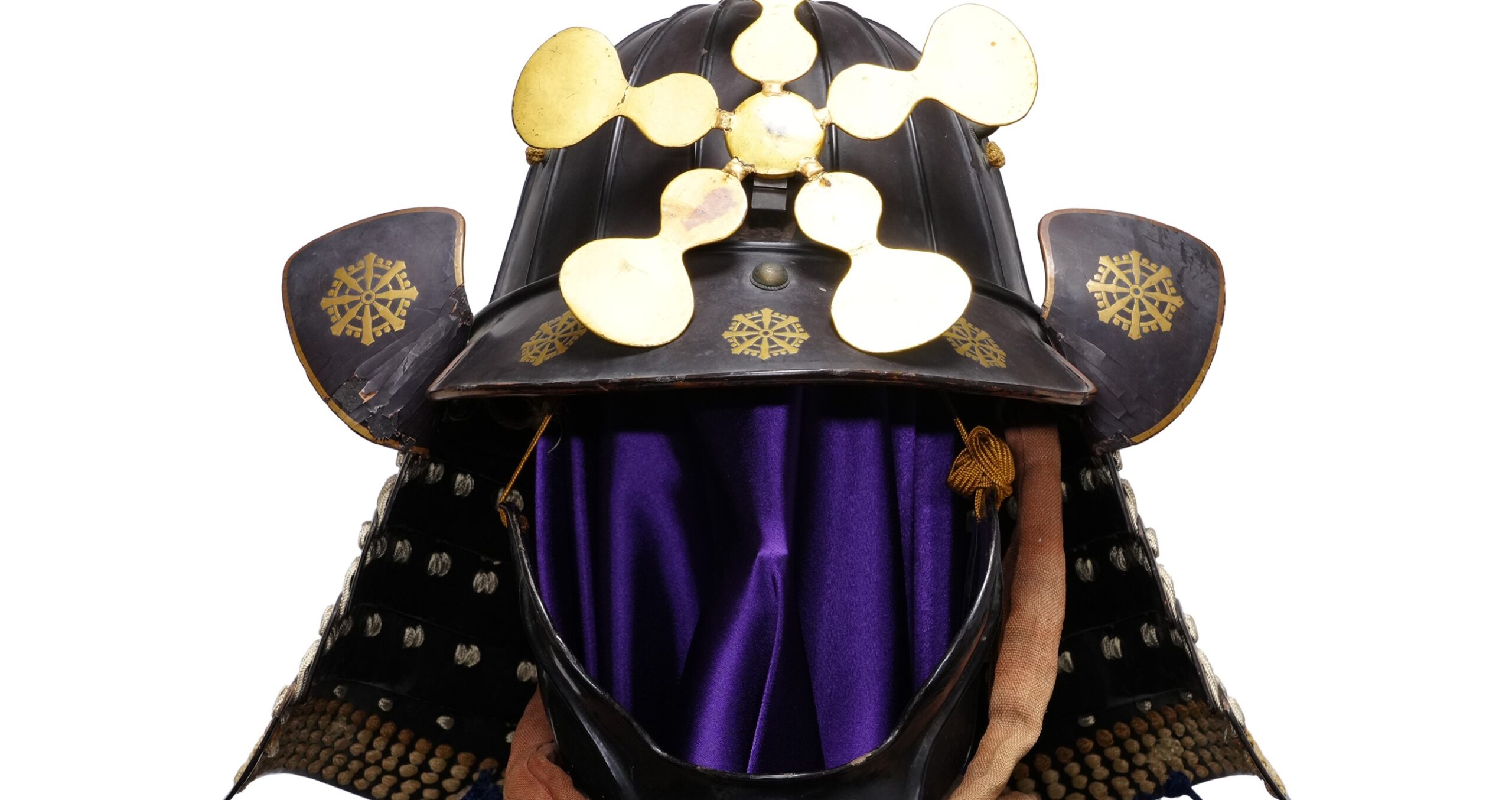
■Menpo (face guard): Hanbō
This type of half mask is called the Hanbō (半頬) and was popular as it was easier to breathe than the full mask covering his nose. The purpose of Menpo was not only to protect Samurai’s face. But also to hide their true faces so that their psychological states were unaffected.
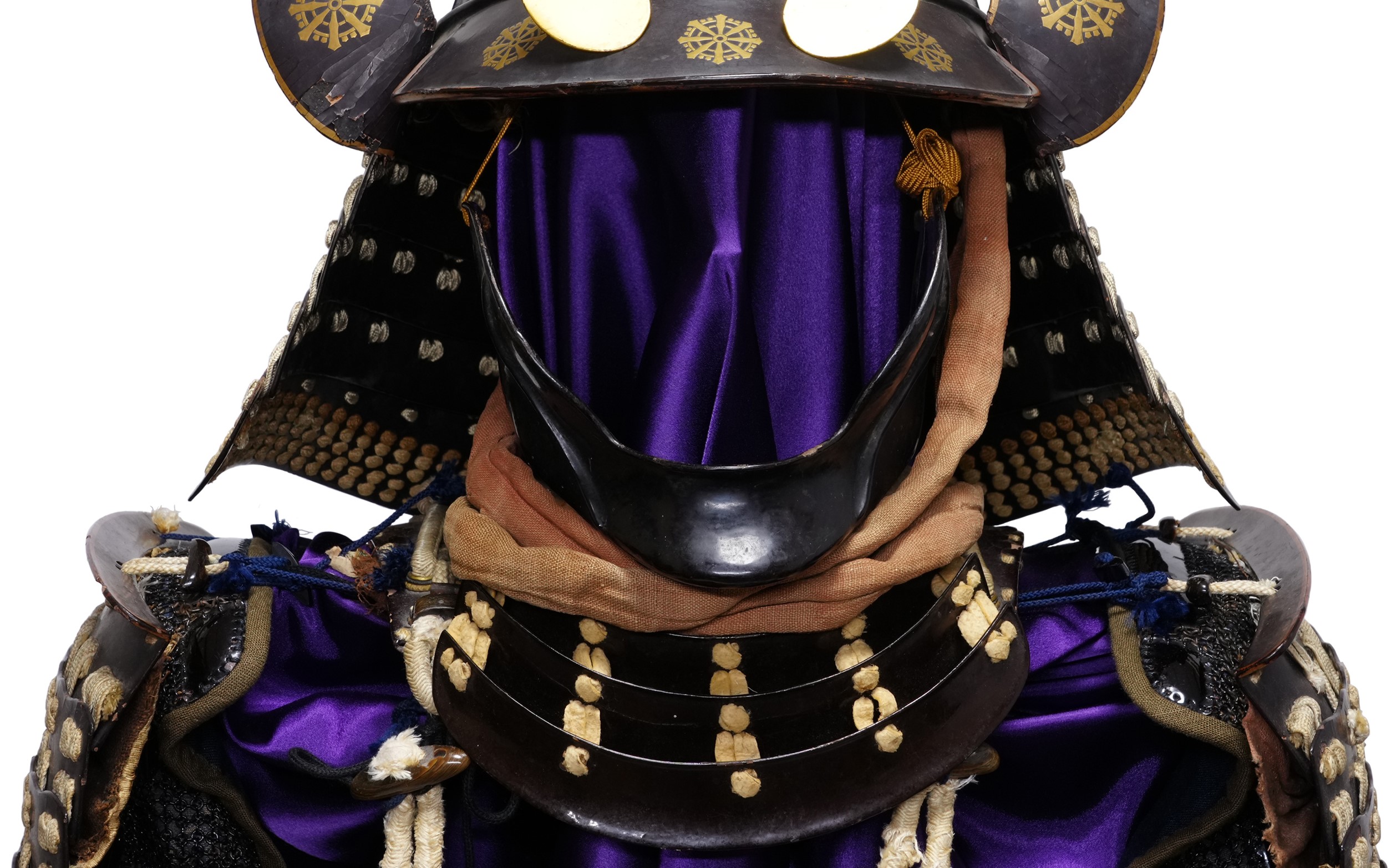
■ Maedate (Front decoration): Itsutsu Hisago
The family crest of this Kabuto’s Maedatemono (前立物, front decoration) is colored with golden paint. And it is called the Itsutsu Hisago Mon (五つ瓢紋), which is categorized in the Hisago (瓢, gourd-generally called Hyoutan in Japanese) pattern. The Itsutsu Hisago Mon draws five gourds in the shape of a car by putting their heads together. Since ancient times, Japanese people have appreciated this plant design as an auspicious motif. For example, a Hisago is written as “瓢,” which can also be read as “Hyou.” Therefore, three Hisagos were considered the San-Byoushi (三拍子, triple time, 拍子 can also be pronounced as Hyoushi). And people compared six Hisagos to Mubyou Sokusai (無病息災, be in perfect health). It is because the word “病 (Byou)” has the same pronunciation as “瓢 (it also can be read as Byou).” Also, the Hisago pattern represents success in business and the prosperity of descendants as this plant produces lots of fruits. These meanings tell you how Japanese people love this design based on its acting superstitiously for good luck.
Now let’s briefly touch on an example of the relationship between the Hisago motif and the Samurai culture. Toyotomi Hideyoshi (豊臣 秀吉, 1537-1598) is one of the most famous Samurais during the Warring States period (1467-1615). According to a theory, his Umajirushi (馬印, a massive flag raised near the general Samurai on the battlefield) was the Senari-Byoutan (千成瓢箪). He was given the Hisago motif for his Umajirushi from Oda Nobunaga (織田 信長, 1534-1582). It is said he added gourds every time he won the battles. We imagine this plant motif has been treated as an auspicious symbol and cherished among Samurai warriors.

Armor
■Dō (cuirass): Nimai Dō
Nimai Dō is a kind of cuirass for Tousei Gusoku (当世具足, developed armor style). Nimai Dō (二枚胴) was named after the fact that Nimai (二枚) means two plates, and Dō (胴) means torso in Japanese. Instead of using a large number of small lamellar plates called Kozane (小札), this cuirass used large iron plates riveted.
One feature that characterizes this armor is the dragon design drawn on the Dō. The figure of the dragon is expressed using high-quality gold. Its appearance gives us a majestic and powerful impression. This dragon is depicted with the Makie (蒔絵) technique. It is a typical Japanese lacquer art technique developed uniquely in Japan for about 1,200 years. Firstly, it needs to draw a picture with lacquer on the surface with a thin brush. Next, sprinkle the gold powder from above to show the pattern before the lacquer hardens. This technique makes a gorgeous and elegant look to works, as seen here.
Initially, the dragon was an imaginary creature found in ancient foreign traditions or myths. Furthermore, it is regarded as a symbolic beast of auspicious signs. Its body is likened to nine animals: antlers are deer, the head is a camel, eyes are demons, the neck is a snake, the belly is Mizuchi (蛟, a mythical animal in Japan that looks like a snake and has a horn and four legs), scales are fish, claws are falcons, palms are tigers and ears are cows. It was thought that the dragon would reign at the top of all animals because of its odd-looking appearance.
In addition, if you focus on this dragon’s left hand, you will find that it brings a ball-shaped object in its hand. It is the Nyoi Houju (如意宝珠, Cintāmaṇi), a fantasy jewel that fulfills any desire and gives out treasure, clothes, food, and drinks. Moreover, it heals illness and suffering, removes evils, purifies muddy water, and prevents disasters. It is said this magical item is taken from the brain of the dragon king.
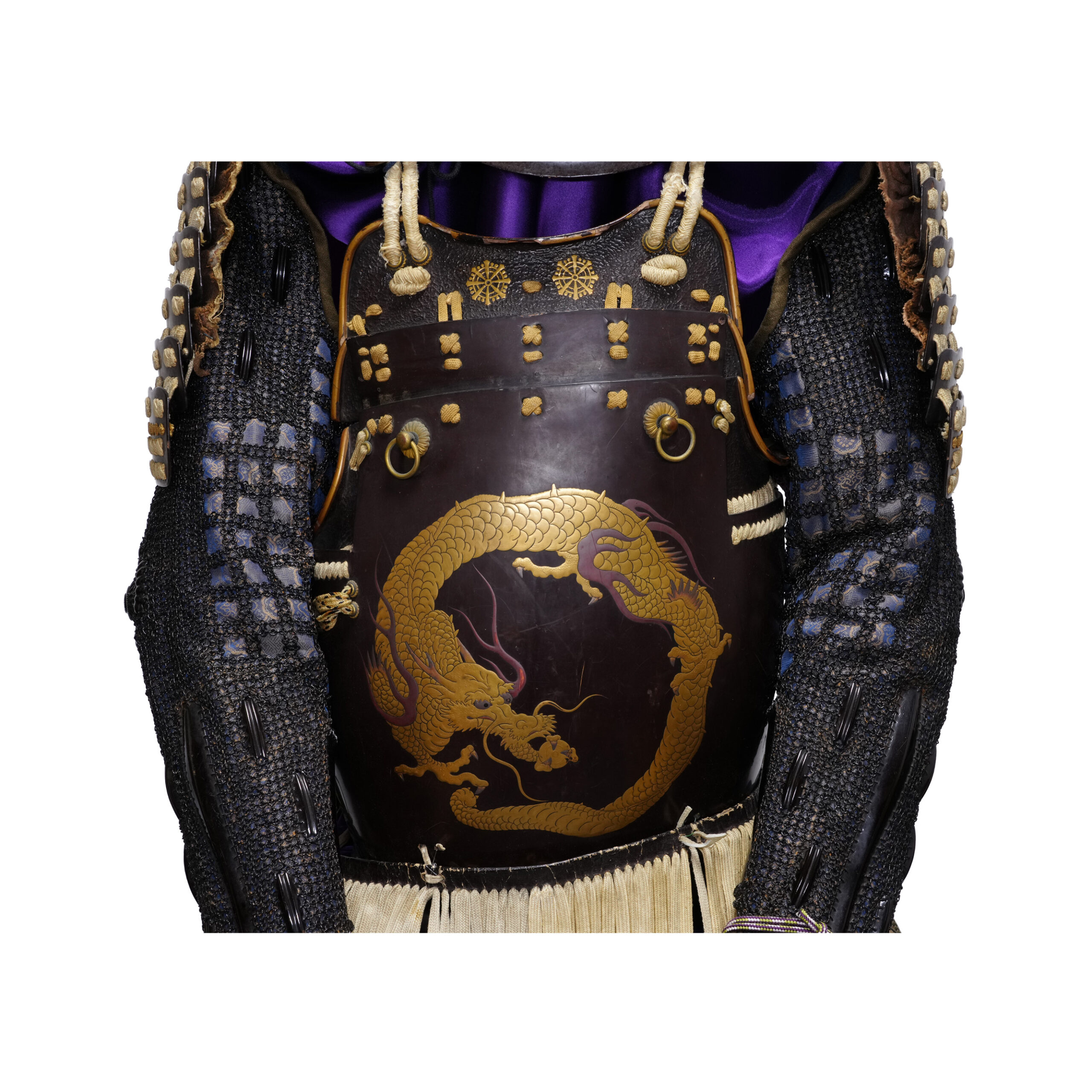
■Kusazuri (skirt of plates attached to the cuirass):
Lacquered iron Kusazuri laced with white threads. There are parts where the cords that support these plates are broken; it is necessary to adjust them appropriately with strings, lines, etcetera, when displaying this armor.
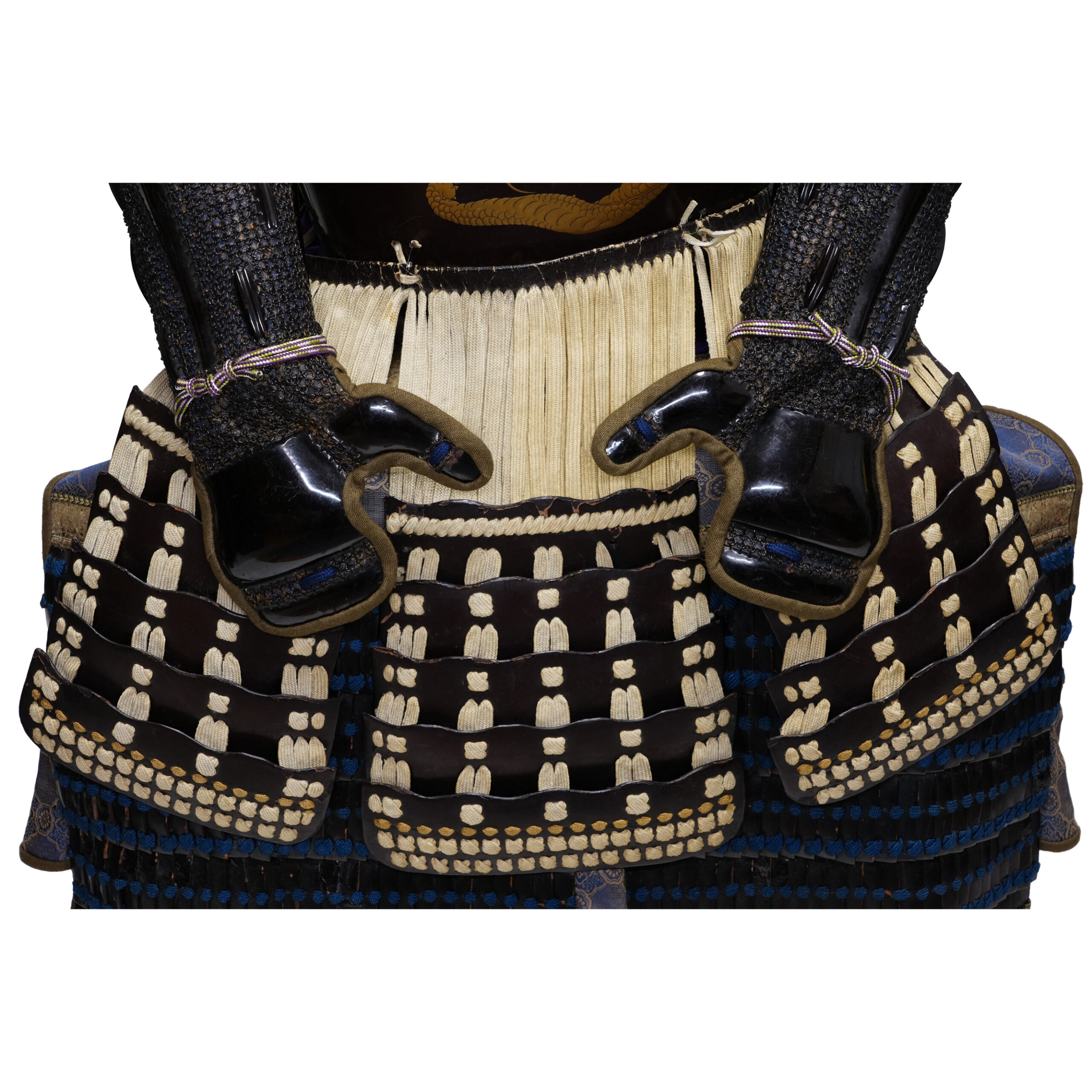

Small parts
■Kote (armored sleeves):
Intricate iron chain mail with silk.
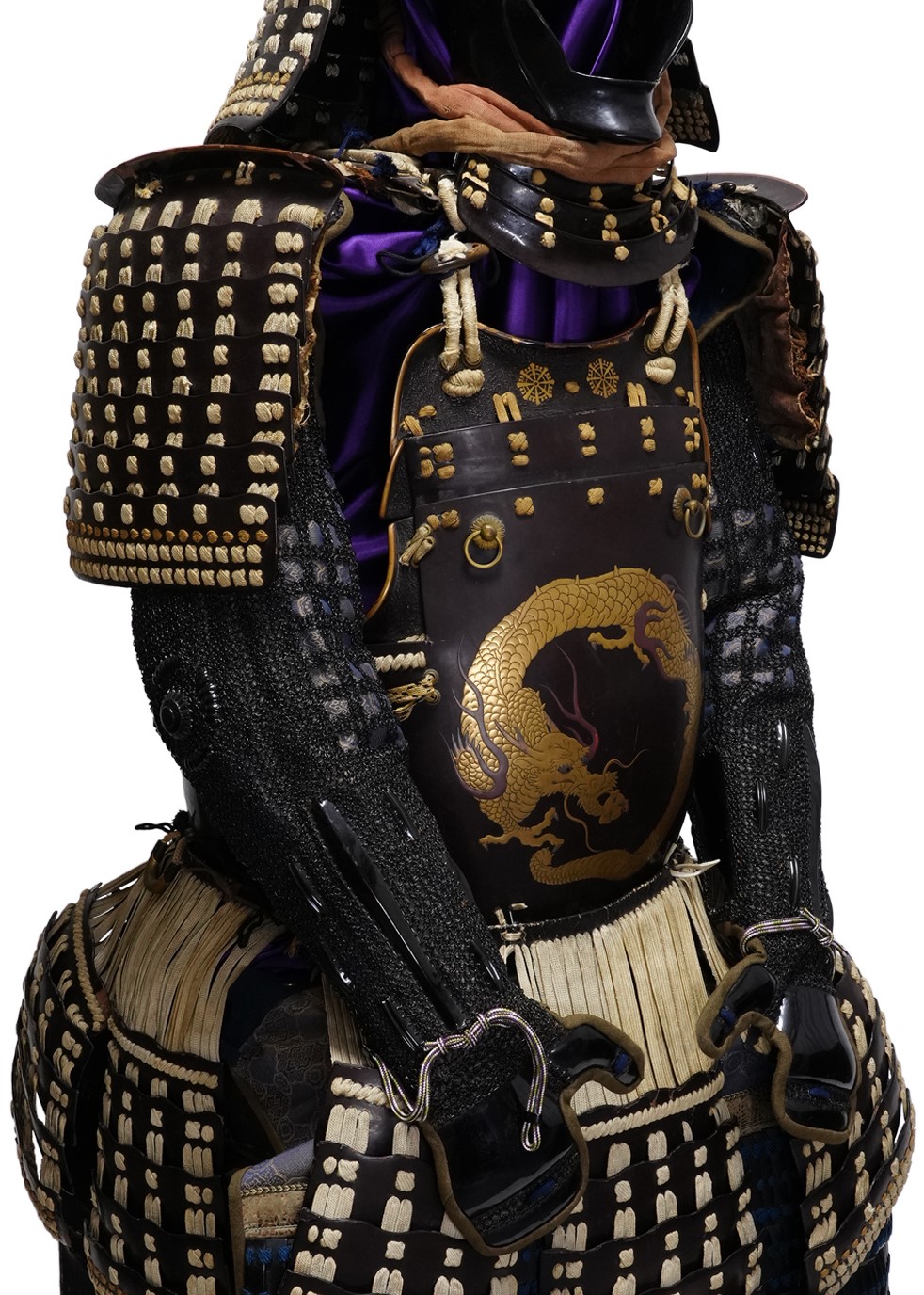
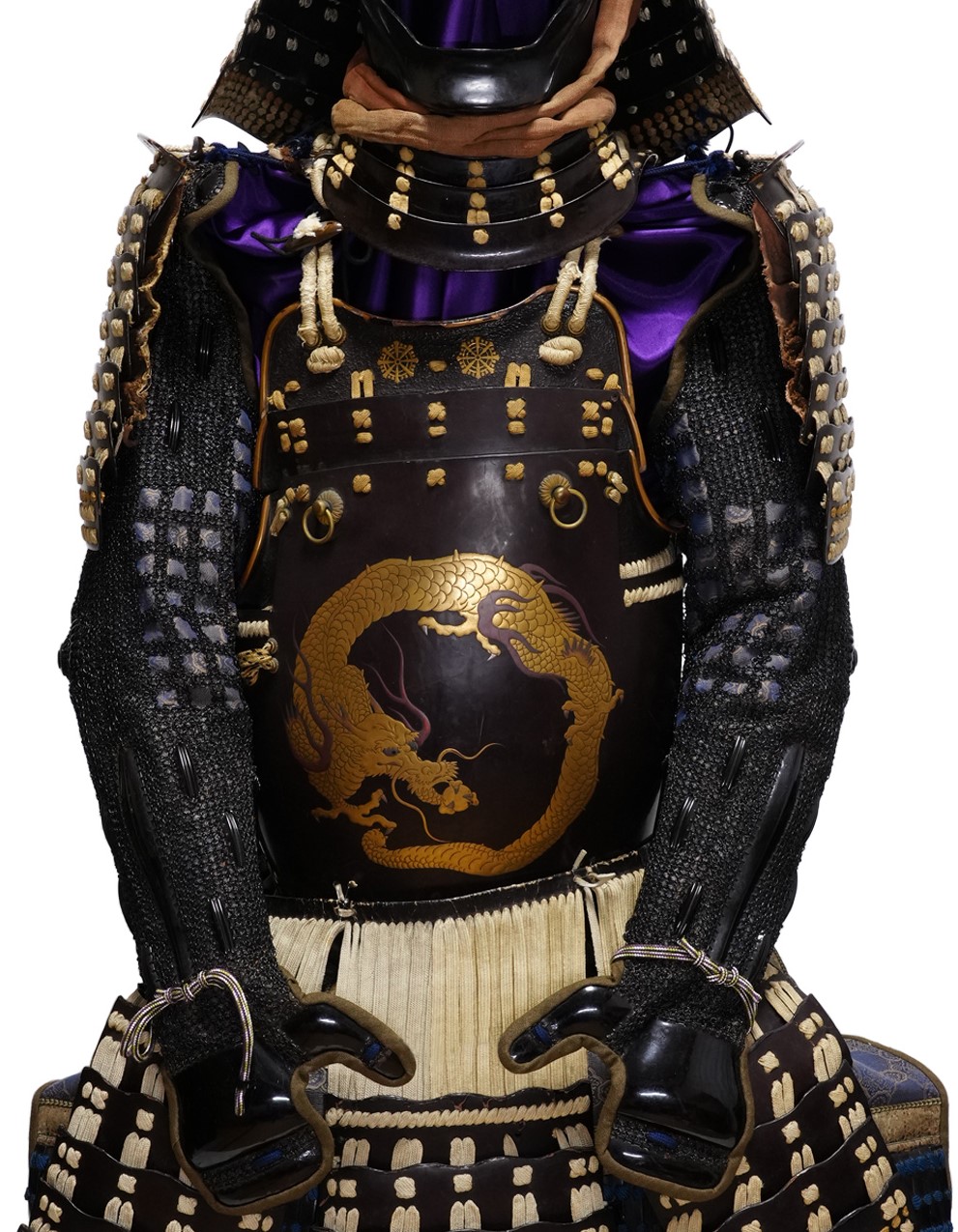
■Haidate (thigh protection):
The Haidate (佩楯) is a thigh guard. Unlike other parts, navy blue threads are used to tie metal plates.
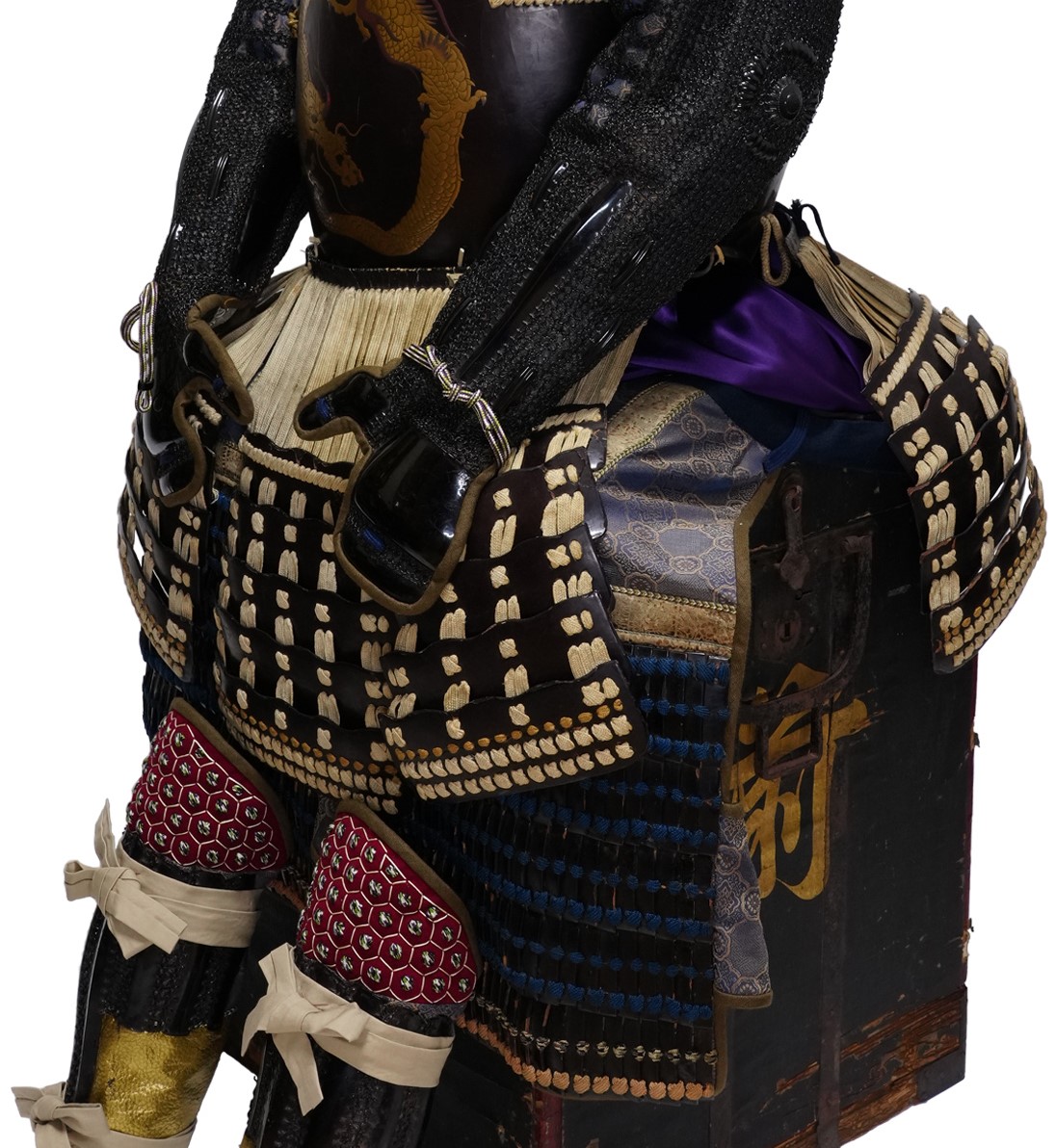
■Suneate (shin guard):
The Kikkou (亀甲, turtle’s shell) pattern is used for the cloth of the Suneate (脛当). It is a continuous geometric pattern connecting regular hexagons up and down. A theory says that this design was brought from China and the Korean Peninsula during the Asuka (飛鳥, 592-710) and Nara (奈良, 710-794) periods. A proverb says turtles live long lives; therefore, turtle and turtle shell patterns represent longevity. In addition, as this continuous hexagonal pattern does not get out of its shape, it is said people wished for eternal prosperity by using this design.
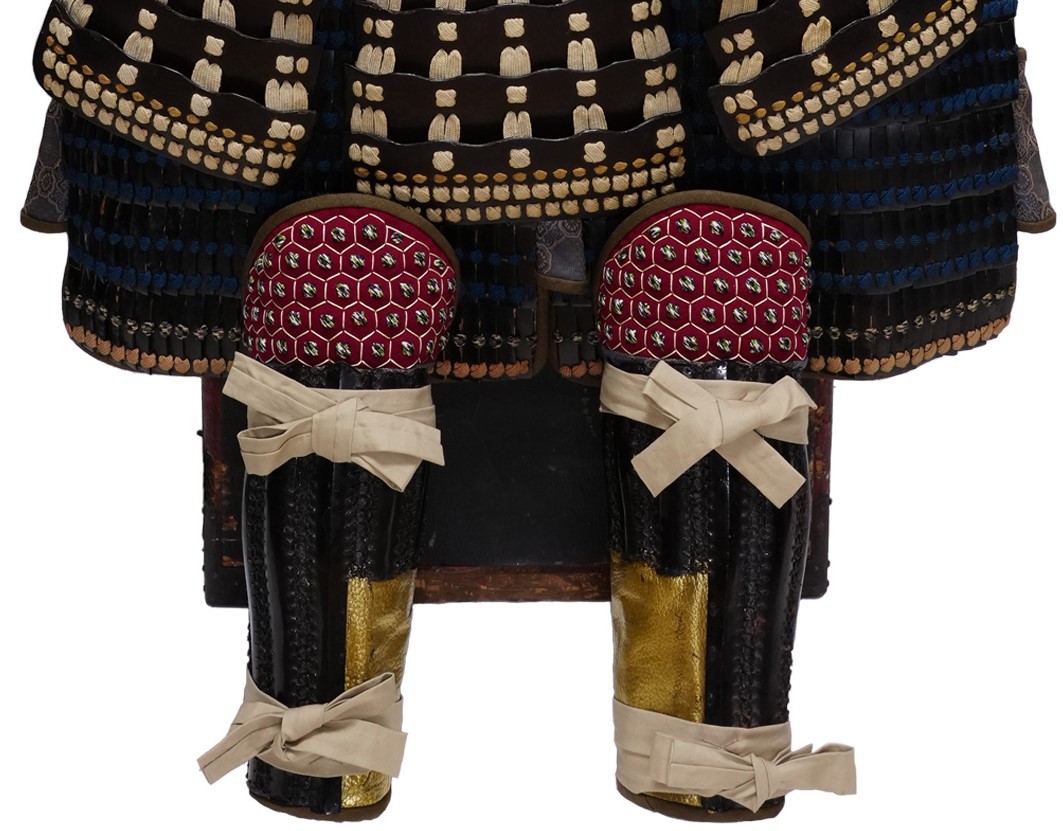
■Gattari (Sashimono holder):
If you focus on the back of this armor, you will find a black-colored metal plate attached. It is a gear called the Gattari (合当理) that supports the upper part of the Sashimono (指物, a frag or decorative sign installed at the back of armor). And the Uketsutsu (受筒)/ Sashidutsu (指筒) is a tube to store a Sashimono. Samurai warriors judged their sides and enemies on the battlefields by checking the motifs designed for flags. Especially in group battles with infantry, this method was very effective because they could instantly identify affiliations.
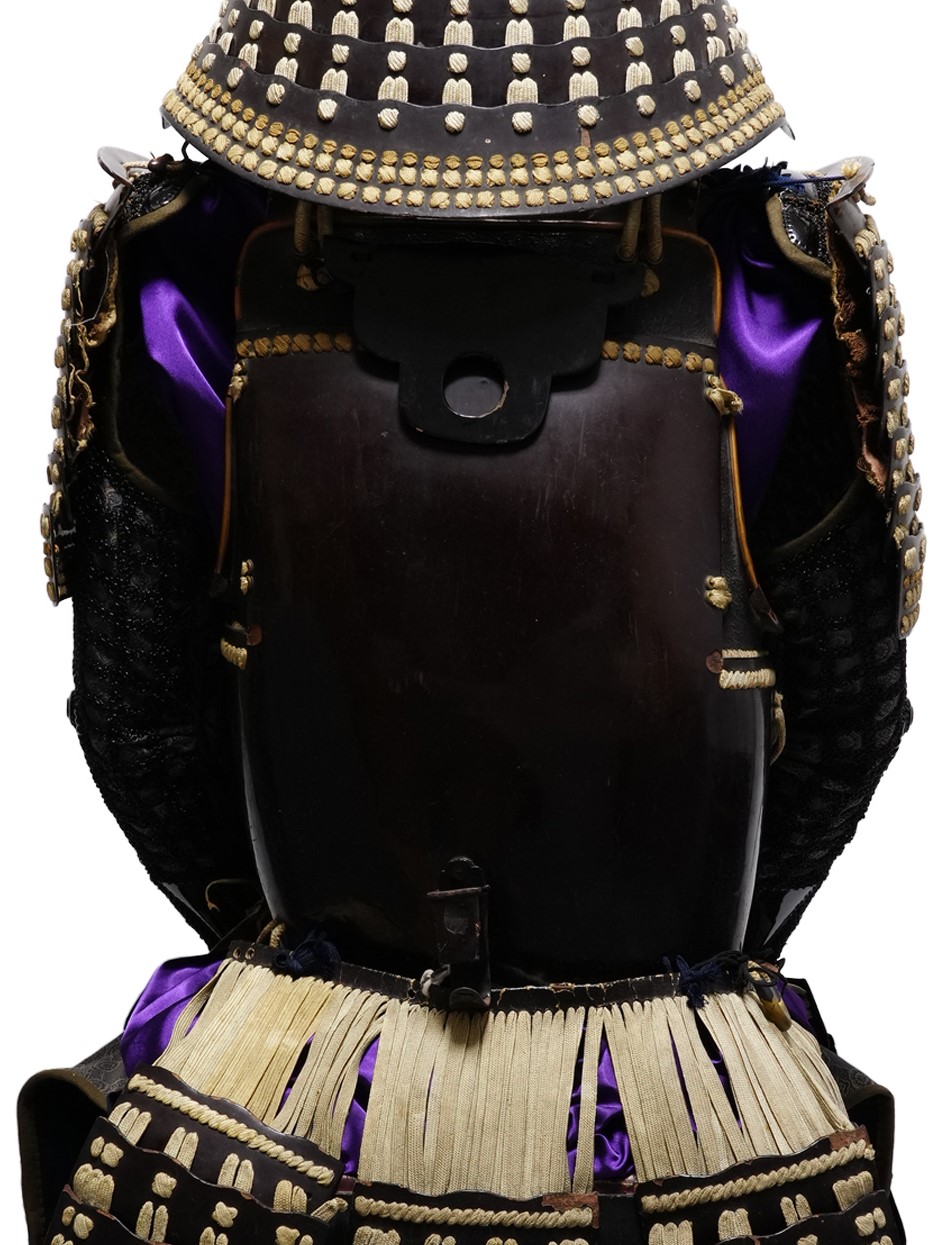
■Kacchu-Hitsu (armor box):
You would find a gold-colored mark on the side of this armor box. We think it is designed as a family crest here. The Hidari-ni Sankai Matsu Mon (左に三階松紋) is probably its theme, which is categorized as a type of the Matsu (松, pine tree) pattern. Since pine trees keep their green color throughout the years by withstanding severe heat and cold, people thought this plant pattern represents eternal youth. Furthermore, its color is called the Tokiwa-Iro (常盤色, evergreen trees’ dark green color with brown), and pine trees have another name Tokiwa-Gi (常盤木). Tokiwa means immutability, so Tokiwa-Iro is a color that praises green with a wish for longevity and prosperity.

Certification: Tokubetsu Kicho Shiryo Certificate (No. 1887)
On May 30th 2021, this armor was appraised as a Tokubetsu Kicho Shiryo by The Association for the Research and Preservation of Japanese Helmets and Armor, which is the most trusted Japanese armor appraiser in Japan. Tokubestu Kicho Shiryo means special rare article. It is ranked as the third highest of five rankings.
The paper mentions the armor was made in the late Edo period (mid 18th-mid 19th). You can receive this original authentication paper.
An English translation of the certificate is available on request. We won’t charge any additional fee.
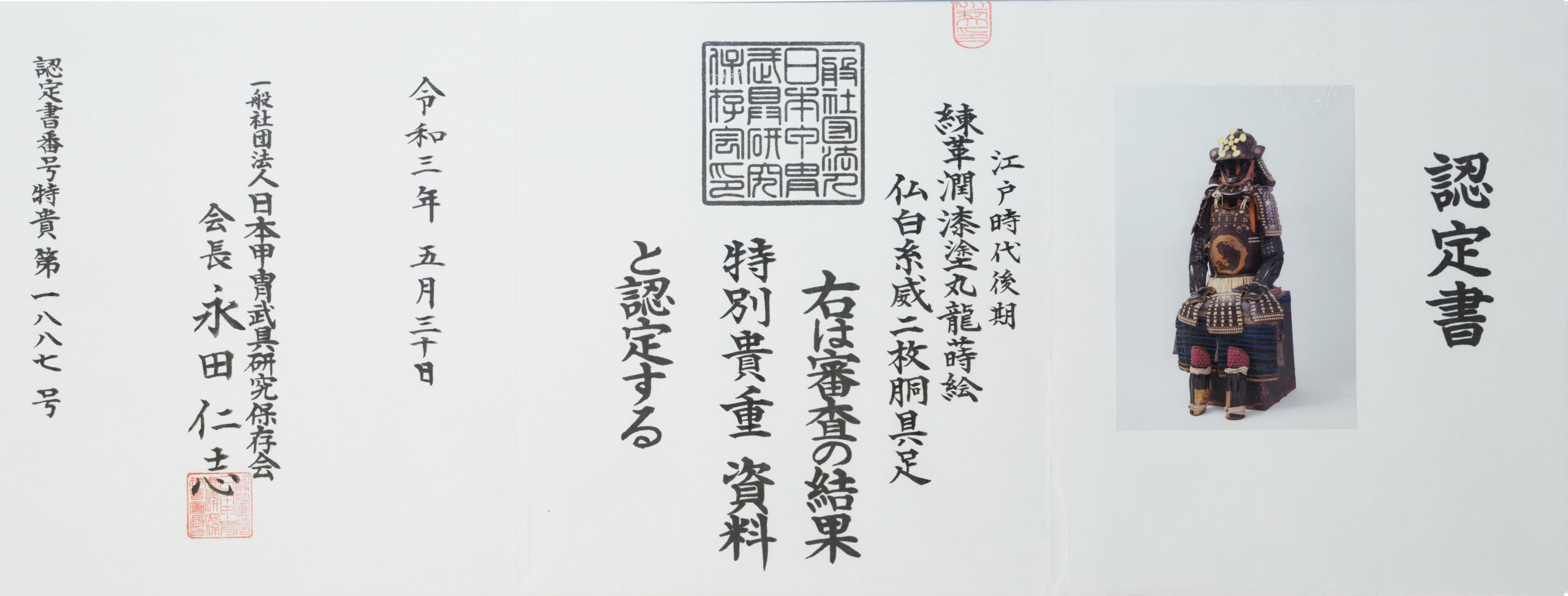
【About us】
Samurai Museum is located in Tokyo, Japan, exhibiting antique artifacts related to the Samurai history. Samurai Museum Shop is the place for those who are interested in Japanese culture and craftsmanship. We deal with antique Samurai swords/armor, traditional crafts made in Japan and so on.
【Antique Japanese Armor and Export process】
After receiving the full payment from you, we will apply for its export permit from the agency for Cultural Affairs to legally export the antique Samurai armor to other countries. It normally takes around 2-4 weeks to receive this permit. And we would like you to expect at least 1-1.5 months for your order to arrive at your given address after you ordered.
【Payment method】
We accept payment through Stripe (Credit card), PayPal, Apple Pay or ChromePay, all of which are secure payment methods. Also, you don’t need to make an account on Stripe for the checkout. If you prefer other payment method, please contact us. You may either pay in JPY, USD, AUD, CAD, EUR, CHF or GBP. The price is set in Japanese Yen. Prices in other currencies are automatically calculated based on the latest exchange rate.

【Shipping duration】
We normally ship via EMS (Express Mail Service) provided by Japan Post. It usually takes at least 5-14 days to deliver the package after you place an order. We offer Free International Shipping as long as we can ship your order by EMS. If you prefer other shipping carriers, please contact us.
We will inform you of the order’s tracking number via email. Please make sure you fill out your valid email address correctly.
*Please keep in mind that due to the spread of COVID-19, there might be possible delays in delivery. If you like to make sure if EMS shipping is available to your country, please contact us.

【How to make sure the condition】
Please keep in mind that what you are going to purchase is an antique item. We uploaded high resolution photos for you to check its condition thoroughly. If you like to see more photos with different angles, please feel free to contact us. We will be happy to send them to you so that you can make informed decision. It is essential for us to know that you are happy with your choice of a sword. and we are prepared to use the best of our ability to serve you.
【How To Contact Us】
Please contact us through email, Facebook Messenger or Live Chat if you have any questions. You can find each icon on the right side of the website. Please click one of them to reach us. We will reply to you within 1-2 business days.
【How To Preserve Antique Samurai Armor】
Dryness, humidity, and bad ventilation might deteriorate the condition of antique Samurai armor. The best temperature to preserve Samurai armor is around 20℃ in Celsius, and humidity should be about 60%. Direct sunlight should be avoided. We recommend storing armors in a room with good ventilation. If you like to display them outside the boxes for a prolonged time, we suggest using a glass case in order for dust not to be accumulated easily. In case you don’t use a glass case, please make sure to regularly dust off from the armor by using a soft brush made of delicate cloth or brush for painting.
If you like to know more about the preservation of this armor, please feel free to contact us.

